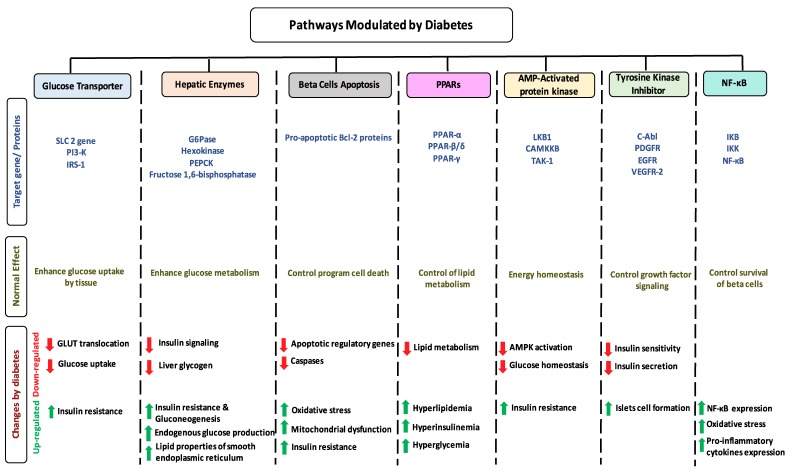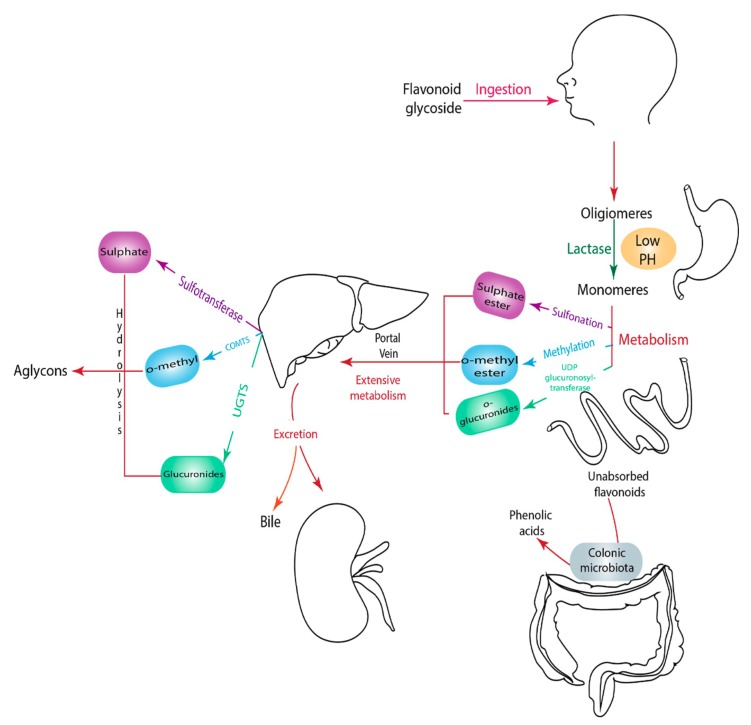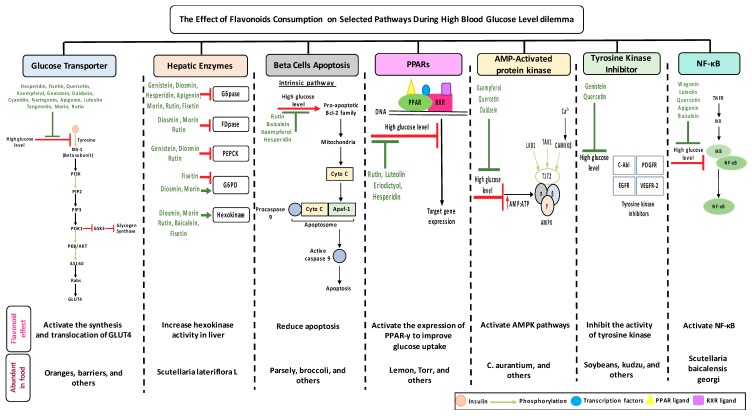Abstract
Diabetes mellitus (DM) is a prevailing global health metabolic disorder, with an alarming incidence rate and a huge burden on health care providers. DM is characterized by the elevation of blood glucose due either to a defect in insulin synthesis, secretion, binding to receptor, or an increase of insulin resistance. The internal and external factors such as obesity, urbanizations, and genetic mutations could increase the risk of developing DM. Flavonoids are phenolic compounds existing as secondary metabolites in fruits and vegetables as well as fungi. Their structure consists of 15 carbon skeletons and two aromatic rings (A and B) connected by three carbon chains. Flavonoids are furtherly classified into 6 subclasses: flavonols, flavones, flavanones, isoflavones, flavanols, and anthocyanidins. Naturally occurring flavonoids possess anti-diabetic effects. As in vitro and animal model’s studies demonstrate, they have the ability to prevent diabetes and its complications. The aim of this review is to summarize the current knowledge addressing the antidiabetic effects of dietary flavonoids and their underlying molecular mechanisms on selected pathways: Glucose transporter, hepatic enzymes, tyrosine kinase inhibitor, AMPK, PPAR, and NF-κB. Flavonoids improve the pathogenesis of diabetes and its complications through the regulation of glucose metabolism, hepatic enzymes activities, and a lipid profile. Most studies illustrate a positive role of specific dietary flavonoids on diabetes, but the mechanisms of action and the side effects need more clarification. Overall, more research is needed to provide a better understanding of the mechanisms of diabetes treatment using flavonoids.
Keywords: diabetes mellitus, flavonoids, hyperglycemia, anti-diabetic, lipogenesis
1. Diabetes and Flavonoids
1.1. Diabetes Mellitus
Diabetes mellitus (DM) is one of the epidemics challenging public health problems throughout the world [1]. The prevalence rate of diabetes is increasing exponentially and the World Health Organization predicts that by the year 2030, diabetes is expected to be the seventh leading cause of death worldwide [2,3]. Diabetes mellitus is a metabolic disorder characterized by the elevation of blood glucose due to the defects in insulin action, secretion or both (insulin is insufficient or inefficient) [4]. Type 1, type 2, and gestational diabetes are the three main types of diabetes targeting children, adults, and pregnant women, respectively [5]. The internal and external factors such as obesity, urbanization, genetic mutations, and a lack of physical activities contribute to the pathogenesis of diabetes [6]. The symptoms and signs of diabetes include polyuria (frequent urination), polyphagia (increased hunger), polydipsia (increased thirst), weight loss, and unconsciousness [7]. Diabetes could lead to deleterious complications like nephropathy, atherosclerosis, and cardiac dysfunction and target major organs in the body such as heart, nerves, kidneys, eyes, and blood vessels [8]. The high mortality and morbidity rate of diabetes combined with the higher risk of bacterial or viral infections or the development of cancer is a major concern of the diseases epidemic [9]. While currently there is no cure, diabetes is successfully treated by managing a healthy lifestyle combined with the administration of anti-diabetic agents and hypoglycemic drugs such as sulphonylureas, thiazolidinediones (TZDs), and biguanides all of which reduce blood glucose [10].
1.2. Glucose Homeostasis
Following a carbohydrate rich meal, the level of glucose in the body is regulated by two primary hormones: Insulin and glucagon [11]. The digestion of most starch molecules occurs in the upper gastrointestinal tract where they get hydrolyzed into smaller molecules (monosaccharides) which are absorbed through glucose transporters (GLUT) into the blood stream [12]. The GLUT-family is encoded by SLC2 genes and is responsible to transport monosaccharide, polysaccharide, and other small compounds through the membrane [13]. Fourteen GLUT proteins are expressed in human; GLUT 1-12, GLUT 14, and a myo-inositol transporter (HMIT) [14]. GLUT 2 is responsible to transport glucose from the circulation to pancreatic β cells where it gets oxidized and leads to the secretion of insulin [11]. The reduction of blood glucose levels occurs through three main mechanisms: (i) The enhancement of a glucose uptake by peripheral tissues through the translocation of GLUT 4; (ii) the inhibition of lipolysis and the promotion of lipogenesis; and (iii) the promotion of glucose storage and utilization in the liver [11]. One the other hand, when the glucose level in the body is low, the level of glucagon secretion increases due to two mechanisms: (i) The promotion of glucose production and release in the liver and (ii) the promotion of lipolysis and releasing free fatty acids from adipose tissue [14,15].
1.3. Insulin Resistance
Insulin resistance is defined as an impaired sensitivity to insulin due to an increase insulin secretion [16]. The different mechanisms explain the causes of insulin resistance in diabetic patients are: abnormal insulin production; impaired post-receptor signaling (major cause); insulin receptor mutation; and the presence of an insulin antagonist in the body [17]. The defect in glucose uptake due to the down-regulation of GLUT 4 translocation is considered to be the primary metabolic abnormality in type 2 diabetes which occurs as a result of tyrosine phosphorylation inhibition of insulin receptor substrate (IRS-1) [18]. The inhibition of an insulin signaling pathway occurs due to increased phosphatase activities, such as protein tyrosine phosphatase (PTP1B) and tensin homologue (PTEN), which dephosphorylate signaling molecules and inhibit insulin signal [19]. Cell exposure to free fatty acids (FFAs) and tumor necrosis factor alpha (TNF-α) inhibit the phosphorylation of IRS-1 that inhibit insulin signaling and action [20]. A suppressor of cytokine signaling (SOCS-1 and 3) shows a different underlying mechanism which blocks the downstream insulin signaling pathway by competing with IRS-1 to associate with the insulin receptor (IR) [21]. The accumulation of lipids in skeletal muscle and liver activates the pathways which negatively affect an insulin signaling pathway resulting in the reduction in both glucose uptake by skeletal muscle and glycogen synthesis in the liver [22]. In order to combat insulin resistance, the body increases the production of insulin to maintain euglycemia leading to an increase in the size of islet cells and pancreatic β-cells [23].
1.4. Insulin Release Defect in Diabetes
Type 2 diabetes is characterized by the high glucose level in the blood (hyperglycemia), the alteration in β-cells size and function, and insulin resistance [24]. Apoptosis caused by lipotoxicity, intracellular and extracellular deposit of islets amyloid polypeptide (IAPP), and glucotoxicity decreases the β-cells size which alter their functions [25]. As Β-cell mass decreases and its functions reduces, the cells are unable to compensate for the higher demand of insulin secretion due to insulin resistance [26]. Chronic hyperglycemia caused by chronic over-nutrition has proven to induce β cells apoptosis by endoplasmic reticulum stress (ER), a high level of intracellular calcium, the production of reactive oxygen species (ROS), and oxidation stress [27]. A high level of FFAs could also stimulate pro-apoptotic effects on β-cells that diminish their functions [28].
1.5. Lipogenesis Regulation in Adipocytes
Adipocyte differentiation, cellular lipid droplets accumulation, and adipogenesis occur in the body due to adipocyte transcription factors, like peroxisome proliferator-activated receptor gamma (PPAR γ) and adipokines, such as resistin [29]. PPAR γ is a nuclear hormone receptor which is expressed mainly in the adipose tissue [30]. It is important in glucose homeostasis, insulin sensitivity, adipogenesis, and energy metabolism. It also is critical in inducing the uptake of glucose and fatty acids by the cells [31].
Adiponectin, another regulating factor to lipogenesis, is primarily involved in improving glucose and lipid metabolism. It also inhibits the expression of multiple pro-inflammatory cytokines, such as tumor necrosis factor alpha (TNG-α), which promotes lipolysis and increases FFAs production [32].
The absence of leptin, an adipocyte-secreted hormone, leads to severe metabolic derangements. The main role of leptin is to regulate food intake and promote the oxidation of FFA in the peripheral tissues to prevent lipid deposition [33]. Insulin resistance leads to hyperleptinemia, which induces leptin resistance and results in lipotoxicity [34].
1.6. Diabetes Management
Diabetes is a lifelong multifactorial disease with micro- and macro-vascular complications. This has prompted different pharmacological and non-pharmacological therapeutic agents and measures to be implemented to benefit diabetic patients with the aim of enhancing their quality of life [35]. The currently available treatment for diabetes mainly manages to reduce and regulate glucose metabolism [36]. The first line of intervention for diabetic patients is to change their lifestyle to a healthier diet and to physical activities [37].
The administration of insulin is routinely used for type 1 diabetic patients as their pancreatic β- cells are incapable of secreting insulin, and type 2 diabetic patient’s due to their inability to respond to circulating insulin [38]. Managing diabetes is also achieved by using some antidiabetic compounds that reduce blood glucose levels. In addition, surgical operations, like bariatric surgery, can help obese patients with their diabetes management if other interventions become difficult to contain the disease and its complications [39].
Managing diabetes is not simple as it requires continuous support, medical attention, and education to patients to prevent serious complications. Sustainable management of diabetes is a global necessity due to the increase in the morbidity rate of the disease.
1.7. Impact of Diabetes on Selected Pathways
Micro and macrovascular complications of diabetes are associated with long term damage and organ failure [8]. A glucose transporter pathway is a rate limiting step for glucose utilization which is defective in diabetes [40]. Two isomers, GLUT1 and GLUT4, are involved in glucose transport through the cell membrane [14]. In diabetic patients, the translocation level of GLUT4 decreased which reduces glucose uptake and increases insulin resistance (Figure 1) [41]. The level and activity of hepatic enzymes, such as glucose-6-phosphate dehydrogenase, decreases with diabetes [42]. These changes enhance insulin resistance and gluconeogenesis and reduce insulin signaling and liver glycogen [43]. As a result of the reduced activity of peroxisome proliferator-activated receptor (PPARs) in diabetes, a significant reduction in lipid metabolism has been observed which leads to hyperinsulinemia and hyperglycemia [44]. Diabetes can also enhance the activation of apoptotic pathways by reducing the activity of apoptotic regulatory genes and caspases that upregulate mitochondrial dysfunction and insulin resistance (Figure 1) [45].
Figure 1.
Schematic illustration of seven selected pathways modulated by diabetes. The figure is divided into seven columns and three rows. The column headings represent the pathways, while the rows heading represent: target genes/proteins for each pathway (blue), the overview physiological effect of these genes on pathways (Dark yellow), and changes occur on these pathways modulated by diabetes.
1.8. Dietary Flavonoids
Nutraceuticals are natural products derived from fruits and vegetables which provide multiple health benefits [46]. Scientific attention has been given over the past 20 years toward natural compounds, such as flavonoids serving as an antidiabetic agent [47].
Flavonoids are polyphenols which are ubiquitously found in daily consumed fruits, vegetables, nuts, cocoa, tea, grain seeds, and herbs [48]. They represent a large class of approximately 8000 phenolic compounds [49]. Flavonoids are considered as a class of biologically active secondary metabolites of plants known as pigment producers accountable for the odor and color of the flowers, where they serve antiviral, anti-allergic, antibacterial and anti-inflammatory functions [50]. The structure of flavonoids consists of 15 carbon skeletons and two aromatic rings (A and B) connected by a three-carbon chain which is usually an oxygenated heterocyclic C ring [51]. Based on the generic structure of a C ring, functional groups present on the ring, and the position where the B ring is attached to the C rings, six subclasses of flavonoids are defined: flavones; flavonols; flavanones; flavan-3-ols; isoflavones; and anthocyanosides [52].
Flavonoids have multiple positive health effects on metabolic disorders, such as cardiovascular disease, cancer, obesity, and diabetes [53]. Research and clinical studies have postulated the function of flavonoids in preventing and treating certain viral diseases like influenza [54]. They also serve as antioxidants which modulate oxidative stress in the body by neutralizing the effect of nitrogen and oxygen species, thus preventing the disease [55]. The antidiabetic activity of flavonoids supports the regulation of carbohydrate digestion, insulin signaling, insulin secretion, glucose uptake, and adipose deposition [56]. They target multiple molecules that are involved in the regulation of several pathways, like improving β-cell proliferation, promoting insulin secretion, reducing apoptosis, and improving hyperglycemia by regulating glucose metabolism in the liver [57]. A US study on 200,000 women and men evaluated the association between dietary intake of flavonoids subclasses and type 2 diabetes, confirming that a higher consumption of anthocyanins from apples, blueberries, and pears, lowers the risk of diabetes [58]. It is hypothesized that the majority of flavonoids bioactivity occurs due to their hydroxyl group, α, and β ketones [59].
1.9. Metabolism of Flavonoids
Flavonoids hydrolyze and conjugate the main enzymes in the intestine, colon, and liver. In the intestine, the hydrolyzed and conjugated enzymes convert monomeric units of flavonoids into O-glucuronides, sulfate ester, and O-methyl ester [60]. The conjugation of flavonoids occurs in two phases: The small intestine (phase one), and then in the liver, the end of phase one and the beginning of phase two occurs. In the liver, the conjugated metabolites undergo further processing to produce sulfate and glucuronide derivatives where they get facilitated and excreted through bile and urine (Figure 2) [61]. Unabsorbed flavonoids move to the colon where they undergo hydrolysis or fermentation by colonic microbiota [62]. Flavonoids glucuronides in the liver are hydrolyzed by microbiota into aglycones where they break down further to lower molecular compounds that can be easily absorbed [63].
Figure 2.
Illustration of a flavonoid pathway in the human body. The glycoside of flavonoids enters the body by an oral ingestion. An enzymatic reaction in the stomach (green arrow) breaks down the flavonoids to simpler molecules. In the small intestine, the first conjugation of flavonoids occurs where several reactions take place, such as sulfation and methylation, leading to the formation of o-glucuronides, o-methyl ester, and sulfate ester. The second conjugation of flavonoids take place in the liver to produce sulfates and glucuronides derivatives which could be excreted through bile and urine. Unabsorbed flavonoids enter the colon to be hydrolyzed or fermented into lower molecular compounds which can easily be absorbed.
1.10. Search Strategy and Selection Criteria
Medline, Scopus, and PubMed were searched for papers published from 1985 using the search terms “flavonoids”, “phytochemicals”, “flavonoids AND anti-diabetics”, “flavonoids hyperglycemia”, “flavonoids lipid peroxidation AND diabetes”, “flavonoids AND diabetes mellitus”, “phytochemicals diabetes mellitus”, "flavonoids OR flavonoids subclasses AND diabetes”, and “flavonoids subclasses AND diabetes”. The search yielded approximately 5044 articles, and in this article, 240 articles were selected and analyzed in detail.
2. Anti-Diabetic Effects of Selected Flavonoids
2.1. Flavonol
Flavonols are characterized by an unsaturated carbon ring at carbon 2–3 which is oxidized at C4 while hydroxylated at C3. They are found abundantly in lettuce, grapes, onions, kale, and berries [64].
2.1.1. Quercetin
3,5,7,3’,4’-Pentahydroxyflavone or quercetin dihydrate (C15H10O7) is the most abundant flavonoid in human dietary nutrition. It is found mostly in flowers, apples, seeds of tomatoes, berries, fennel, tea leaves, nuts, onions, broccoli, pepper, lovage, and shallots [65,66]. Quercetin acts as the base for the formation of other flavonoids skeletons, such as naringenin, rutin, and hesperidin [67]. Quercetin is involved in several biological actions such as: glucose homeostasis; insulin sensitizing and secreting; glucose utilization in peripheral tissues; the inhibition of intestinal glucose absorption [68]. Quercetin intake is inversely associated with the prevalence of T2DM in the Chinese population which suggests its preventive activity against T2DM [69,70]. A recent systematic review and meta-analysis of animal studies showed that quercetin decreases serum levels of glucose at doses of 10, 25, and 50 mg/kg of body weight [71]. Quercetin extracted from berries induced an insulin independent 5’ adenosine monophosphate-activated protein kinase (AMPK) pathway which slows the oxygen consumption of adenosine diphosphate by stimulating GLUT 4 translocation and expression in isolated mitochondria. This mechanism has a similar activity as metformin (medication used to treat type 2 diabetes) [72]. The antidiabetic action of quercetin involves the reduction of lipid peroxidation, glucose absorption by GLUT2, and the inhibition of insulin dependent activation of phosphoinositide 3-kinases (PI3K) [73,74]. In addition to this, quercetin and its derivatives (Table 1) stimulate a glucose uptake in muscle cells, and activate AMPK [75]. Treating streptozotocin (STZ)-induced diabetic rats with quercetin decreases the activity of glucokinase, hyperglycemia stimulating GLUT 4, hepatic gluconeogenesis, and glycogenolysis while it increases glucose liver uptake [76]. Quercetin supplementation for two weeks lowered the blood glucose level, upregulated the expression of genes involved in cell survival and proliferation in a liver, and enhanced the serum insulin in STZ- induced diabetic mice [77]. An injection of quercetin intraperitoneally into STZ- induced diabetic rats, reported a decrease in hyperglycemia, plasma cholesterol and triglycerides, and an improve glucose tolerance and hepatic glucokinase activity [78]. The co-treatment of quercetin and sitagliptin (a selective dipeptidyl peptidase-IV inhibitor) demonstrated an improvement in its oxidative and inflammatory status, metabolic profile, glycemic control, β-cells function, and islet structure in STZ- induced DM in rats [79]. Quercetin blocks the activities of a tyrosine kinase inhibitor, which has shown an effect against diabetes (Figure 3). The regulatory effect of quercetin to nuclear factor kappa-light-chain-enhancer of the activated B cells (NF-κB) also helps in improving glucose stimulated insulin secretion [80] (Figure 3).
Table 1.
Representative flavonol and their underlying anti-diabetic effects.
| Flavonoid Subclass | Name of Flavonoid | Structure of Flavonoid | Dietary Source | Metabolites Produced from Flavonoids | Function of Flavonoids | Mechanism of Action | Model Used | References | |
|---|---|---|---|---|---|---|---|---|---|
| In Vivo | In Vitro | ||||||||
| Flavonol | 1. Rutin |
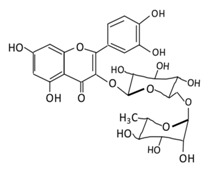
|
Oranges, grapes, limes, lemons, berries and peaches. | Metabolization depends on intestinal bacteria: (A) Bacillus 52 and Bacteroides 45 produce: Quercetin-3-O-glucoside and Leucocynaidin. (B) Bacteroides 42 and veillonella 32 produces: Leucocynaidin. (C) Bacteroides 22 hydrolysis produce: Quercetin-3-O-glucosie |
(A) Antihyperglycmeic effect: (B) Hypolipemic effect |
Inhibit α-glucosidase and α-amylase which reduce the absorption of glucose in small intestine Decrease G6Pase, PEPCK, glycogen phosphorylase, and fructose-1,6-bisphosphatase enzymes in liver and kidney Decrease the level of caspase 3 and increase the level of Bcl-2 which shows an anti-apoptotic activities Reduce the level of hemoglobin A1C (HbA1c) Activate the synthesis and translocation of GLUT4 that stimulate glucose transport to soleus muscle tissue Increase hexokinase activity in liver Improve the morphology of islets of Langerhans Reduce serum LDL, VLDL, triglyceride Inhibit lipid peroxidation Increase serum level of HDL Activate the expression of PPAR-γ which improve glucose uptake and insulin resistance |
Streptozotocin induced diabetic rats Type 2 diabetic rat Streptozotocin induced diabetic wistar rats |
Streptozotocin diabetic tissue |
[81,83] |
| 2. Fisetin |
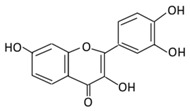
|
Onion, strawberries, and persimmon | (A) Glucuronide of fisetin (M1) (B) Glucuronide (M2) (C) Methoxylated metabolites of fisetin (M3) |
(A) Antihyperglycmeic effect |
Inhibit gluconeogenesis by inhibiting pyruvate transport into mitochondria Decrease glycogen breakdown which prevent hyperglycemia Reduce blood glucose, Hb1Ac, IL-1β, and NF-κB p65 unit Reduce the activity of glucose glucose-6-phosphate dehydrogenase activity |
Streptozotocin induced diabetic rats |
[107,108] | ||
| 3. Kaempferol |
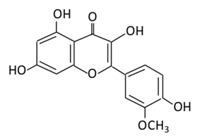
|
Cruciferous vegetables, tea, grapefruit, edible berries, and Gingko biloba L. | (A) Kaempferol-3-O-glucoside (B) Kaempferol-3-O-diglucoside |
(A) Antihyperglycmeic effect: (B) Hypolipemic effect |
Reduce serum glucose level and fasting blood glucose level Decrease the level of caspase 3 activity in β-cells Inhibit cellular apoptosis by improving anti-apoptotic Akt activities Improve cAMP signaling and insulin synthesis and secretion Improve glucose uptake by soleus muscles Reduce lipid peroxidation Decrease PPARγ expression through AMPK activity |
Rats Streptozotocin (STZ)-induced diabetic rats High fat diet mice |
Pancreatic β-cells | [90,91] | |
| 4. Quercetin |
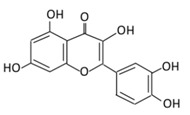
|
Black currants, cherries, apples and chokeberries | (A) Quercetin-3-O-glucoside (B) Quercetin -3-O-glucoside-7-O-glucoside (C) Quercetin-3-O-galactoside (D) Aglycone |
(A) Antihyperglycmeic effect: (B) Hypolipemic effect |
Inhibit insulin dependent activation of PI3K Inhibit GLUT2 which reduces the absorption of glucose in small intestine Block the activity of tyrosine kinase Improve GLUT4 translocation through the activation of AMPK Improve the recovery of cell proliferation Improve glucose absorption Reduce lipid peroxidation |
Rats Streptozotocin (STZ)-induced diabetic rats High fat diet mice |
Skeletal muscle cells Hepatocyte RINm5F β-cells |
[68,69] | |
| 5. Isorhamnetin |
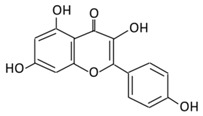
|
Oenanthe javanica, Hippophae rhamnoides, and Ginkgo biloba L. | (A) Isorhamnetin (B) isorhamnetin-3-O-galacto |
(A) Antihyperglycmeic effect: (B) Hypolipemic effect: |
Improve insulin secretion Increase glucose transporter 2 (GLUT2) Inhibit adipogenesis |
HFD- induced C57BL/6 mice | 3 T3-L1 cells | [102,103] | |
| 6. Morin |
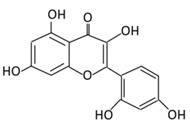
|
Psidium guajava, Prunus dulcis (Almond), chlorophora tinctoria, and fruits | (A) Morin glucuronides (B) Morin sulfates |
(A) Antihyperglycmeic effect: (B) Hypolipemic effect. |
Reduce hepatic NF-κB activation Reduce G6Pase and FDPase enzymatic activities Increase hexokinase and G6PD enzymatic activities Improve hyperglycemia, insulin resistance, and glucose intolerance Reduce lipid peroxidation Reduce hyperlipidemia Normalize the profile of lipid and lipoprotein |
Streptozotocin (STZ)-induced diabetic rats High fructose fed rats HFD-STZ induced type 2 diabetic rats |
Rats hepatocyte | [114,115] | |
Figure 3.
Flavonoids as anti-diabetic agents: Modes of Action. Aberrant signaling pathways (Glucose transporter, hepatic enzymes, beta cell apoptosis, PPARS, AMPK, Tyrosine kinase inhibitor, and NF-κB) and pathway components targeted by flavonoids (highlighted in green). Flavonoids have a wide range of anti-diabetic actions where one flavonoid could target multiple pathways. These phytochemicals can enhance or suppress (green and red lines respectively) the activity of GLUT 4 translocation, glucose uptake by the tissue, and hepatic enzymes activities; causes a decrease in apoptosis and tyrosine kinase inhibition that improves the pathogenesis of diabetes (see text for detailed modes) of action for flavonoids mentioned). For abbreviation, see abbreviation list.
2.1.2. Rutin
Rutin is extracted from plants, such as oranges, lemons, grapes, peaches, limes, and buckwheat [81]. Rutin is also known as glycosylated quercetin, sophorin, and quercetin-3-O-rutinosie [82]. The anti-diabetic effects of rutin includes the reduction of carbohydrates absorption from the small intestine, the improvement of glucose uptake by tissues, the suppression of tissue gluconeogenesis, the activation of insulin secretion from β-cells, and the protection of the islets of Langerhans from degenerative changes. Rutin also lowers the formation of reactive oxygen species, advanced glycation end-product precursors, sorbitol, and pro-inflammatory cytokines [83]. Several experimental studies evaluated the hypolipemic and antihyperglycemic effects of rutin [84] (Table 1). The oral or intraperitoneal administration of rutin (50 mg/kg or 100 mg/kg) into a STZ model of type 1 diabetic rats significantly decreased glycated hemoglobin (HbA1c) and fasting blood glucose (FBG) [85]. When diabetic rats were fed with 100 mg/kg rutin, a significant increase in insulin levels and carbohydrate metabolic enzymes activity occurred. Further, the results showed a significant reduction in the level of plasma glucose [86]. The administration of rutin activates hepatic enzymes involved in the gluconeogenic and lipid metabolic process, such as hexokinase (Figure 3) [87]. The flavonoid also decreases significantly the level of urine protein, blood urea nitrogen, oxidative stress intensity, and fasting blood glucose. The treatment of rutin showed anti-apoptotic activities by increasing the activity level of B-cell lymphoma 2 (Bcl-2) and decreasing the level of caspase-3 in diabetic retina (Figure 3) [88]. Compared with other flavonoids like boswellic, quercetin, and ellagic acid, rutin was the most active flavonoid in reducing FBG, serum lipids, and improving glucose tolerance [89].
2.1.3. Kaempferol
3,4,5,7-Tetrahydroxyflavone is a nontoxic flavonoid that is abundant in grapes, apples, onions, tomatoes, beans, kale, broccoli, potato, tea, and spinach [90]. Kaempferol has neuroprotective, antimicrobial, antioxidant, anti-inflammatory, and anticancer effects [91]. The extracts of kaempferol from Bauhinia forficate leaves reduce hyperglycemia and enhance glucose uptake, mimicking the action of insulin [92]. In vitro studies confirmed that treating with 10 μM of kaempferol enhances cellular viability and represses apoptosis [93]. Kaempferol has several antidiabetic effects, like improving AMP activated cellular protein expression and activation, reducing cellular apoptosis by suppressing caspase 3 activities, and increasing the production and secretion of insulin from β-cells [94] (Figure 3). In addition to this, kaempferol enhances glucose uptake by the cells through protein kinase C and PI3K pathways, and the synthesis of new glucose transporters [95]. The oral administration of kaempferol significantly decreased serum HbA1c levels, fasting blood glucose, and increased insulin resistance. This flavonoid decreased the genetic expression of PPARγ mediated through regulating AMPK activation [96] (Table 1). Moreover, kaempferol improved DM in STZ-induced mice through the promotion of glucose metabolism in skeletal muscle, and the suppression of hepatic gluconeogenesis [97]. In another study, kaempferol attenuated diabetic nephropathy in NRK-52E and RPTEC cells via suppressing RhoA/Rho-kinase mediated pro-inflammatory signaling (i.e., TNF-α, IL-1β, and TGF-β1) [98]. Like kaempferol, resveratrol is a natural phenol found in grapes, blueberries, and peanuts with potent antioxidant and anti-inflammatory activities that could effectively prevent diabetes [99,100].
2.1.4. Isorhamnetin
An O-methylated bioactive compound is found commonly in medical plants, like Oenanthe javanica (Chinese celery, Japanese parsley, blume, minari in Korean), Hippophae rhamnoides (known also as sea- buckthorn), and Ginkgo biloba (commonly known as ginkgo) [101]. This flavonoid has anti-obesity and anti-diabetic effects [56]. The oral administration of isorhamnetin for 10 days into a streptozotocin-induced model of diabetes (STZ) at a dose of 10 mg/kg or 20 mg/kg showed an effective reduction in oxidative stress and hyperglycemia. The anti-diabetic effect of isorhamnetin is, not only limited to reducing the blood glucose level, but also it helps in reducing the accumulation of sorbitol level on rat lenses, the sciatic nerve, and red blood cells. [102]. An experimental study proposed that isorhamnetin glycoside has several effects on diabetes, like stimulating insulin secretion, the expression of enzymes involved in lipid metabolism, and the expression of endoplasmic reticulum stress markers [103,104].
2.1.5. Fisetin
3,7,3’,4’-Tetrahydroxyflavoneis found abundantly in fruits and vegetables like apples, grapes, persimmon, cucumber, onions, and strawberries [105,106]. Fisetin possess anti-diabetic, anti-inflammatory, and neurotrophic effects [107]. The oral treatment of fisetin in a dose of 10 mg/kg for 30 days decreased Hb1Ac, blood glucose levels, and the expression of the gluconeogenic genes protein level, while it increased the concentration of plasma insulin [108]. In an in vivo study, the results showed that treatment with fisetin significantly reduced the level of NF-κB p65, Hemoglobin A1C (HbA1c), serum nitic oxide (NO), and blood glucose [109]. Fisetin also inhibits high glucose induced cytokine production in monocytes which could prevent diabetes [110]. The anti-diabetic effects of fisetin on hepatic enzymes include enhancing the activities of hexokinase, while reducing the activities of glucose 6 phosphate dehydrogenase (G6PD) and glucose 6-phosphatase (G6Pase) (Figure 3). Moreover, fisetin improves glucose homeostasis by attenuating carbohydrate metabolism enzymes in STZ diabetic rats [111]. Fisetin has been reported to improve the development of diabetic cardiomyopathy in STZ- induced DM rats by improving hyperglycemia/hyperlipidemia-mediated oxidative stress, the inflammation processes, and the programmed cell death [112]. Preclinical evidence illustrated the therapeutic potential of fisetin in diabetic neuropathy through the modulation of NF-κB and Nrf2 signaling pathways [113].
2.1.6. Morin
A natural flavonoid, morin, is found mostly in traditional medical herbs, like Prunus dulcis, Chlorophora tinctoria L., and fruits such as guava and figs [114]. The oral administration of morin for 30 days in animal models resulted a significant improvement in glucose tolerance, hyperglycemia, and insulin resistance [115]. Diabetic rats were reported to have declined lipid peroxides and antioxidant levels after the treatment with morin [116]. Morin effectively decreased the level of inflammatory cytokines, like IL-6 and TNF-α, which proves its anti-inflammatory effects [117]. In animal models, morin recovered leptin sensitivity and hepatic insulin led to the reduction of liver lipid accumulation and hyperlipidemia [118]. Morin has different effects on hepatic enzymes where it is significantly reduces the activity of G6Pase and Fructose-1,6-diphosphatase (FDPase), while enhancing the activity of hexokinase and G6PD [119] (Figure 3).
2.2. Flavanones
Flavanones are known as di-hydroflavones and they are characterized by an oxidized, saturated carbon ring. Flavanones are widespread in citrus fruits and known for their free radical scavenging ability and antioxidant activity [64].
2.2.1. Hesperidin
5,7,3’-Trihydroxy-4’-methoxyflavanone, a saturated oxidized aglycon, is found abundantly in citrus fruits, such as limes and lemons, tomatoes and cherries [120]. The effects of hesperidin and its glycoside (Table 2) are not limited to diabetes, but also have vascular, neuroprotective, anti-allergic, anti-inflammatory, anticarcinogenic, and antioxidant effects [121]. A study in db/db C56BL6 mice showed that hesperidin supplementation to the regular diet helps in regulating the activity of gluconeogenesis and glycolytic hepatic enzymes, and in improving hyperglycemia [122]. In db/db mice, the flavonoid has a very effective machinery, like increasing triglyceride fecal excretion and inhibiting lipid metabolizing enzymes which enhances the lipid metabolism activities [123]. Hesperidin effectively lowers blood glucose levels by upregulating GLUT 4 translocation and PPARγ [124]. Hesperidin supplementation showed a decrease in glucose 6 phosphatase (G6Pase) activities in STZ- induced diabetic rats, which diminish glucose exports from the cells by a glucose transporter membrane protein [125] (Figure 3). A dose of 10 g/kg diet of hesperidin treatment decreases glucose levels by altering glucose regulating enzyme activities [126]. The administration of hesperidin and hesperetin together have different effects on lipid and glucose metabolism and show lipid lowering activities [56]. Hesperidin also positively regulates the α-Klotho/FGF-23 pathway in STZ- induced DM rats, which demonstrate positive effects on diabetic toxicity in the liver and kidney [127].
Table 2.
Representative flavanones and their underlying anti-diabetic effects.
| Flavonoid Subclass | Name of Flavonoid | Structure of Flavonoid | Dietary Source | Metabolites Produced from Flavonoids | Function of Flavonoids | Mechanism of Action | Model Used | References | |
|---|---|---|---|---|---|---|---|---|---|
| In Vivo | In Vitro | ||||||||
| Flavanones | 7.Hesperidin |
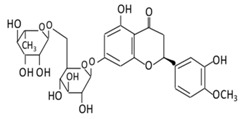
|
Orange citrus aurantium |
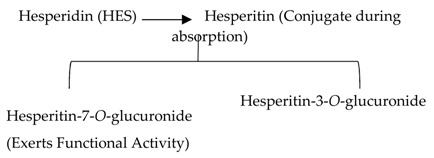
|
(A) Antihyperglycmeic effect: (B) Hypolipemic effect |
Down- regulate the production of free radical and proinflammatory cytokines Reduce oxidative stress Reduce blood glucose level by affecting glucose enzymatic activities Increase glycogen concentration and hepatic glycolysis Reduce the level of TBARS which is a byproduct of lipid peroxidation Normalize adiponectin level Increase the activity of lactate dehydrogenase (LDH) |
Alloxan-induceddiabetic rabbits Streptozotocin (STZ)-induced marginal type 1 diabetic rats (10g/kg diet) |
[122,124] | |
| 8.Naringenin |
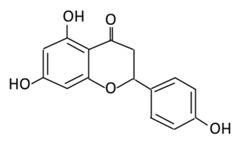
|
Grapefruit (C. paradisi), Chinese herbs like C. aurantium | Four forms could be present in the body two of them are major: (A) Naringenin glucuronides (Major form in serum) (B) Naringenin sulfates ( Major form in liver) (C) Free naringin (Not present in blood stream) D) Free naringenin (Not present in blood stream) |
(A) Antihyperglycmeic effect: (B) Hypolipemic effect |
Reduce poliprotein B secretion in the liver which mimic insulin effect Inhibit intestinal α-glucosidase activity which delays carbohydrates absorption Inhibit glucose uptake by inhibiting sodium glucose co-transporter Activate AMPK pathway which increase insulin sensitivity and glucose tolerance Reduce membrane lipid peroxidation Prevent apolipoprotein B overproduction and dyslipidemia Induce hypolipidemic activity |
Streptozotocin (STZ)-induced diabetic rats High fat diet fed mice LDL receptor null mice Male Sprague-Dawley rats |
INS-1E cells | [133,135] | |
| 9.Eriodictyol |

|
Lemon, Torr, Eridictyon californicum, Millettia duchesnei De Wild, and Eupatorium arnottianum | (A) Monoglucuronide M1 in the liver microsome (B) Monoglucuronide M2 in the liver microsome |
(A) Antihyperglycmeic effect: (B) Hypolipemic effect: |
Suppress oxidative stress Decrease Intercellular Adhesion Molecule 1 (ICAM-1), Vascular endothelial growth factor (VEGF), retinal TNFα, and Endothelial NOS (eNOS). Reactivate Akt phosphorylation Reduce lipid peroxidation Up-regulate the expression of PPARγ2 Up-regulate adipocyte- specific fatty acid binding protein |
Streptozotocin induced diabetic rats (0.2%) |
HepG2 cells Differentiated 3T3-L1 cells |
[144,146] | |
2.2.2. Naringenin
5,7,4’-Trihydroxyflavanone, a saturated oxidized aglycone, is present abundantly in citrus fruits, such as oranges, tomatoes, and grapefruits [128]. It has a wide range of biological activities, such as antioxidant, antidiabetic, anti-inflammatory, anticancer, and anti-mutagenic abilities [129]. Both naringenin and its glycoside (Table 2) possess anti-diabetic and anti-obesity activities [130]. An in vitro study presented that naringenin mimics the effect of insulin by decreasing pro-liprotein B secretion in liver cells [131]. The administration of this flavonoid (25 mg/kg) into diabetic rats showed a significant inhibition of α-glucosidase activity which delayed carbohydrate absorption, therefore, reducing postprandial blood glucose levels [132]. In type 2 diabetic mice, naringin could upregulate GLUT4, and regulates the expression of hepatic enzymes involved in gluconeogenesis and glycolysis which improves hyperglycemia [133,134]. In an everted rat intestinal sleeve, naringenin was found to inhibit the uptake of glucose by inhibiting sodium-glucose co-transporters in the intestine [135]. The administration of naringenin presented various effects in different diabetic rat models: (i) In STZ- induced diabetic rats, the flavonoid decreased the level of plasma glucose; (ii) in fructose-fed insulin resistance rats, naringenin improved insulin sensitivity; in HFD mice, it helped in the reduction of insulin resistance [136,137,138]. Treating diabetic mice with 25 mg/kg for 45 days significantly reduced hyperinsulinemia, hyperglycemia, decreased lipid membrane peroxidation, improved hepatic markers, restored the changes in lipid profile, and enhanced the antioxidants activities [139]. Naringenin anti-diabetic effects in diabetic rats were characterized by anti-oxidant, and anti-apoptotic activities which showed the potential of naringenin to limit neurodegeneration and prevent retinal damage in diabetic retinopathy [140].
2.2.3. Eriodictyol
Eriodictyol, present in lemon fruits, significantly controls obesity and diabetes [141]. Recently, eriodictyol was identified as a novel insulin secretagogue in vitro and in vivo which exerts an exclusive glucose-dependent insulinotropic activity via a cAMP/PKA pathway [142]. Moreover, in diabetic rats, eriodictyol supplementation can effectively suppress oxidative stress [143]. The treatment with eriodictyol upregulated the expression of PPARγ2 and the adipocyte-specific fatty acid binding protein [144]. Furthermore, eriodictyol treatment significantly suppressed diabetes related lipid peroxidation [145] (Figure 3). Recently, eriodictyol was described as a protector of the rat retinal ganglial cells (RGC)-5 from high glucose-induced oxidative stress, inflammation, and cell apoptosis via the activation of Nrf2/HO-1 signaling [146].
2.3. Flavones
The structure of flavones is comprised of an unsaturated carbon ring at C2–3 and a ketone group at C4, but they lack the hydroxylation at carbon 3 if compared to flavonols. They are widely synthesized in flowers, leaves, and fruits [64].
2.3.1. Apigenin
5,7,4’-Trihydroxyflavone is a phytoestrogen aglycoge found mostly in nuts, vine spinach, oranges, celery, garlic, tea, oregano, carrot, and chamomile [147]. In alloxan induced insulin dependent diabetic mice, the oral administration of apigenin for 10 days reduced hepatic antioxidants, like catalase, glutathione, and superoxide dismutase. The treatment with apigenin helps in reducing hyperglycemia, serum cholesterol and G6Pase activities in the liver (Figure 3) [148]. In STZ- induced diabetic rats, the administration of apigenin (4 mg/kg) showed a significant anti-hyperglycemic effect [149]. Apigenin treatment could prevent induced apoptosis through the inhibition of NF-κB activation [150]. In HepG2 hepatocytes, apigenin enhances the phosphorylation of AMPK. This effect of apigenin is 200 times more potent than metformin [49]. The enhancement of GLUT4 translocation upon the treatment with apigenin suggested its effect on lowering blood glucose [151]. Apigenin administration improved oxidative damage of pancreatic β-cells in STZ-induced rats by lowering cellular DNA damage, ROS production, protein carboxylation, lipid peroxidation, and restored cell apoptosis [152]. The administration of apigenin improved STZ-induced diabetic nephropathy through MAPK-NF-κB-TNF-α and TGF-β1-MAPK-fibronectin signaling [153].
2.3.2. Luteolin
5,7,3’,4’-Tetrahydroxyflavone is a well-known anti-inflammatory and antidiabetic agent [154]. It is abundantly found in fruits and vegetables like cabbage, onion leaves, celery, carrots, parsley, peppers, broccoli, and apple skin [155]. Luteolin was reported to initiate insulin action and to enhance the expression of PPARγ target genes (Figure 3) in primary mouse adipose cells [156]. In damaged pancreatic cells, β cells, this flavonoid improves insulin secretion in uric acid by decreasing micro-autologous fat transplantation (Maft), a trans activator of insulin gene through NF-κB signaling pathway [157]. The anti-diabetic effects of luteolin (LU) and luteolin-7-O-glucoside (LUG) improve blood glucose, HbA1c, insulin, and HOMA-IR levels, and inhibit lipid synthesis [158]. Luteolin improves insulin resistance and adipose tissue inflammation by altering M1-like macrophage polarization in adipose tissue [159].
2.3.3. Tangeretin
5,6,7,8 4’-Pentamethoxyflavone is a flavonoid prevalent in citrus fruits, such as oranges, citrus peel of tangerine, and mandarins [160]. The administration of tangeretin (200 mg/kg) in HFD-induced obese mice reduced blood glucose, total cholesterol, body weight and regulated adipocytokines, like leptin, IL-6, and adiponectin [161]. Treating diabetic rats with tangeretin (100 mg/kg) for 30 days reduced glucose plasma levels, Hb1Ac, and enhanced glycolytic enzymes, the level of insulin and hemoglobin significantly [162]. In 3T3-L1 preadipocyte, tangeretin increases the secretion of the insulin sensitizing factor while decreasing the secretion of the insulin resistance factor [163]. In addition, tangeretin down-regulates STZ-induced programmed cell death in INS-1 cells through the regulation of NF-κB signaling [164].
2.3.4. Chrysin
5,7-Dihydroxyflavone is found abundantly in honey, fruits, bee pollen, propolis, and medical plants, such as Passiflora caerulea L. and Tilia tomentosa [165]. This flavonoid is an analog to apigenin but with lower bioavailability due to rapid excretion and metabolism [166]. Chrysin treatment in STZ-induced rats reported an elevation of glucose, MDA, TG, TC, LDL-C and a reduction of HDL-C, total protein, SOD, CAT, and GST [167]. The treatment with chrysin demonstrated an improvement in renal pathology and suppressed collagen-IV protein expressions in renal tissue [168]. In HFD/STZ-induced diabetic rats, chrysin significantly prevented the development of diabetic neuropathy (DN) due to the reduced level of pro-inflammatory cytokines in the serum [169]. Chrysin treatment decreases lipid peroxidation, glucose levels and increases insulin levels in diabetic rats [170]. The data suggest that chrysin has anti-diabetic and antihypertensive effects [171].
2.3.5. Wogonin
5,7-Dihydroxy-8-methoxyflavone is a flavonoid extracted from the root of Scutellaria baicalensis and it has been used as a traditional medicine in East Asian countries [172]. It is associated with anti-inflammatory, neuroprotective, anti-viral, anti-bacterial, and antioxidants effects [173]. Wogonin has several beneficial effects on insulin sensitivity, blood glucose, and lipid metabolism through the activation of AMPK and PPARα [174]. The pretreatment with wogonin attenuated vascular inflammatory effects seen in high glucose induced (HG) vascular inflammation [175]. A preclinical study found that the anti-oxidative and anti-inflammatory of wogonin could attenuate diabetic cardiomyopathy [176].
2.3.6. Diosmin
A naturally occurring flavonoid glycoside was first isolated from Scrophularia nodosa L. in 1925. It can be isolated either from several plant sources or by the dehydrogenation of the flavanone glycoside, hesperidin [177]. The diosmin administration to type 1 diabetic patients showed a decrease in HbA1c and an increase in glutathione peroxidase (GPx) (Table 3) [178]. Rats treated orally with diosmin for 45 days showed a significant decrease in plasma glucose levels, G6Pase, FDPase and an increase in G6PD and hexokinase (Figure 3) [179]. The diosmin treatment at a dose of 50 and 100 mg/kg for one month improved oxidative stress and hyperglycemia in diabetic rats [180]. Diosmin activates imidazoline receptors which increase adrenal β-endorphin secretion and, thereby improving metabolic homeostasis and the alleviation of serum glucose and lipids in STZ-induced type 1 diabetic rats [181].
Table 3.
Representative flavones and their underlying anti-diabetic effects.
| Flavonoid Subclass | Name of Flavonoid | Structure of Flavonoid | Dietary Source | Metabolites Produced from Flavonoids | Function of Flavonoids | Mechanism of Action | Model Used | References | |
|---|---|---|---|---|---|---|---|---|---|
| In Vivo | In Vitro | ||||||||
| Flavones | 10. Baicalein |
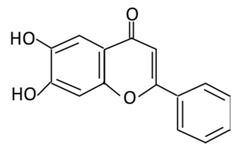
|
Scutellaria lateriflora L, and Scutellaria baicalensis Georgi | In Intestine: Baicalin will be converted into Baicalein and then absorbed rapidly. In the circulation: Baicalein will be converted to Baicalin |
(A) Antihyperglycmeic effect: (B) Hypolipemic effect |
Reduce the level of level of hemoglobin A1C (HbA1c) Suppress the activation of NF-κB Improve glucose tolerance and insulin secretion from pancreatic cells Improve viability of clonal β-cells which improves the production of NADH and NADPH Protect against β cells apoptosis Increase hexokinase activity in liver Activate MAPKs signaling pathway which reduce the effect of insulin resistance by phosphorylating Akt and IRS-1 and dephosphorylate NF-κB Suppress fatty acid synthesis |
Obese diabetic mice Type 2 diabetic rats |
CA1 hippocampal neurons | [187,190] |
| 11. Luteolin |
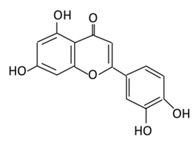
|
Parsley, broccoli, onoins leaves, celery, cabbages, apple skins, carrots, and peppers | Metabolization is medicated by UGTs and COMTs to produce: (A) Luteolin-7-glucuronide (Glucuronidated) (B) Luteolin-4-glucuronide (C) Chrysoeriol/diosmetic (Methylated) (D) Luteolin monoglucuronide (Major form in human serum |
(A) Antihyperglycmeic effect: (B) Hypolipemic effect |
Reduce cAMP response element binding protein and histone acetyl transferase activity of CBP/p300 (NF-κB coactivator) Reduce apoptosis Up-regulate the espression of synaptic protein which target brain cells Improve insulin secretion by supressing Maf A through NF-κB signiling pathway Activate PPAR-γ which targets adiponectin, leptin and GLUT4 genes |
Obese mice Streptozotocin induced diabetic rats Diabetic rats |
Endothelium cells Human monocytes cells |
[155,157] | |
| 12. Diosmin |
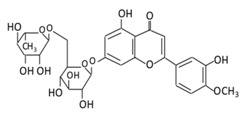
|
Citrus fruites, and Scrophularia nodosa L. | (A) Diosmin (Not excreted in urine) (B) Diosmetin (Not excreted in urine) (C) Minor metabolites in the form of glucuronic acid conjugate (Excreted in urine) |
(A) Antihyperglycmeic effect: (B) Hypolipemic effect: |
Reduce the level of hemoglobin A1C (HbA1c) due to increase in glutathione peroxidase (GPx) Decrease G6Pase, PEPCK, and fructose-1,6-bisphosphatase enzymes Reduce plasma glucose and increase plasma insulin by activating anti-oxidant enzymes Reduce hyperglycemia by inducing β-endorphin Increase hexokinase and glucose-6-phosphate dehydrogenase activity Reduce lipid peroxidation |
Streptozotocin nicotinamide induced diabetic rats |
[179,180] | ||
| 13. Apigenin |
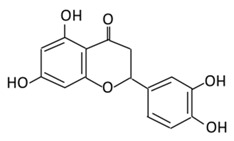
|
Onion, oranges, tea, parsley, chamomile, Hypericum perforatum L, wheat sprouts | Metabolization occurs through two phases: Phase (1): Apigenin produce three monohydroxylated: a) Luteolin b) Scutellarien c) iso-scutellarein Phase(2): Luteolin produce: a) Four monoglucuroconjugates b) Two Sulfoconjugate c) One methyl conjugate |
(A) Antihyperglycmeic effect: (B) Hypolipemic effect: |
Reduce cellular antioxidants Attenuate cell damage in pancreatic β-cells Improve the morphology of the cells Improve GLUT4 translocation which lowers glucose level Increase serum cholesterol Increase lipid peroxidation |
Streptozotocin induced diabetic rats (0.2%) |
HepG2 cells Differentiated3T3-L1 cells |
[147,149] | |
| 14.Tangeretin |
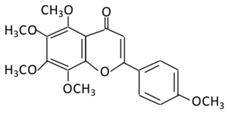
|
Poncirus trifoliate L, citrus fruit rinds, and mandarin orange | Metabolization is medicated by CYP1A1 and CYP1A2 to produce: (A) 4′ hydroxy - 5, 6, 7, 8 tetramethoxyflavone (4′-OH-TMF) |
(A) Antihyperglycmeic effect: (B) Hypolipemic effect: |
Reduce blood glucose and HbA1c level Reduce the secretion of insulin resistance factor Increase the secretion level of insulin and insulin sensitizing factor Enhances glycolytic enzyme in the liver Reduce total cholesterol and adipocytokines level |
Rats Streptozotocin (STZ)-induced diabetic rats High fat diet mice |
Pancreatic β-cells | [160,162] | |
| 15. Wogonin |
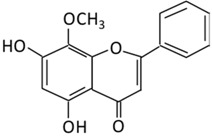
|
Scutellaria baicalensis Georgi | (A) Wogonin-7-beta-D-glucuronide (Major metabolites) (B) Wogonin-5-beta-D-glucuronide |
(A) Antihyperglycmeic effect: (B) Hypolipemic effect: |
Reduce hyperglycemia and lipid droplets accumulation in the liver Increase vascular permeability and the expression of cell adhesion molecules Activate NF-κB and AMPK pathways Activate PPARα which has a beneficial effect on lipid metabolism |
db/db mice | 3T3-L1 cells | [173,175] | |
| 16. Chrysin |
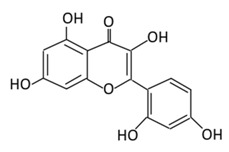
|
passiflora caerulea (L,), honey, Tilia tomentosa Moench, and Pelargonium crispum (Berg.) | (A) Chrysin glucuronides (M1) (B) Chrysin sulfates (M2) |
(A) Antihyperglycmeic effect: (B) Hypolipemic effect: |
Reduce the level of pro-inflammatory cytokines that helps in the prevention of diabetic neuropathy Reduce blood glucose Improve renal pathology with the suppression of TGF-β, collagen-IV, and fibronectin Improve insulin level Reduce lipid peroxidation |
INS-1E cells | [167,169] | ||
2.3.7. Baicalein
5,6,7-Dihydroxyflavone aglycone is isolated from the roots of Scutellaria baicalensis and fruits of Oroxylum indicum L. [182]. It exhibits extensive ant-inflammatory, anti-neuro-degenerative, and anti-cardiovascular effects [183]. The administration of 0.25 g or 0.5 g of baicalein to high fat diet (HFD) induced mice displayed a significant improvement in glucose tolerance, insulin levels, and hyperglycemia [184]. Diabetic rats treated with baicalein showed a substantial decrease in fasting blood glucose levels, HbA1c, food intake, and body weight [185]. Moreover, the treatment with baicalein was reported to decrease the TNF levels, advanced glycation end-products (AGEs), and NF-κB activation (Figure 3) [186]. The baicalein mechanism of action could upregulate AMPK signaling pathways, which can attenuate insulin resistance and inhibit inflammation [187]. The treatment of baicalein in HepG2 cells (0.001 umol/L and 0.01 umol/L) enhanced glucose uptake and glycolysis and suppressed [188]. In addition, baicalein prevents oxidative stress and inflammation in diabetic cardiomyopathy rats through the regulation of PI3K/AKT signaling [189]. Baicalein alleviates hepatic inflammation in diabetic db/db mice via the modulation of HMGB1/TLR4/NF-κB signaling [190].
2.4. Isoflavones
Isoflavones are found mostly in legumes, soybeans, and some microbes [64]. Genistein and daidzein are the major source of isoflavones. They have shown to have an anti-diabetic effect by stimulating insulin secretion from the pancreatic beta cells [56].
2.4.1. Genistein
5,7,4’-Trihysroxyisoflavone, a naturally occurring soy isoflavone, is present numerously in soy, soybean products, and Chinese plants [191]. Genistein exerts the anti-diabetic effects by enhancing plasma lipids [192]. Genistein supplementation in type 1 diabetes animals led to the improvement of insulin levels and glucose metabolism [193]. An in vivo study found that genistein improved hyperglycemia through promoting cAMP/PKA signaling pathways [194]. The administration of genistein to rats fed with a fructose rich diet showed a protective role on renal malfunction through the modulation of insulin resistance [195]. The supplementation of genistein (0.02% in diet) in non-obese diabetic (NOD) rats showed the onset of diabetes was prevented and glucose homeostasis was improved through the preservation of β cell functions [196]. The beneficial effects were observed in non-generic mouse models ingested with 250 mg/kg of genistein like reduction in the fasting glucose level and β cell mass [197]. In STZ-induced mice, genistein improved glucose tolerance, hyperglycemia, and the level of circulating insulin [198]. Genistein demonstrated an inhibitory effect on tyrosine kinase which dysregulates glucose homeostasis (Figure 3) [199]. The administration of genistein to mice reduced body weight and improved glucose and lipid metabolism [200]. A transcriptome analysis revealed that genistein could affect the regulation of the hypothalamic circadian rhythms which could provide a novel target for the therapy of diabetes and obesity. Moreover, genistein has a protective effect against inflammation, neuropathic pain, and oxidative stress [201].
2.4.2. Daidzein
7,4’-Dihydroxyisoflavone is a phytoestrogen mainly isolated from nuts, fruits, and soybeans [202]. Daidzein exerts an anti-diabetic effect by enhancing lipid and glucose metabolism [203]. Daidzein has promising therapeutic potential on impaired glucose, lipid metabolism, and vascular inflammation associated with T2DM [204]. Moreover, daidzein treatment in gastrocnemius muscle is effective in decreasing blood glucose, total cholesterol, and AMPK phosphorylation (Figure 3) [201]. Pure synthetic daidzein administered to hamsters significantly lowered plasma total cholesterol levels and blood glucose compared to the control group [205].
2.5. Anthocyanins
A water soluble, unoxidized, unsaturated flavonoid, anthocyanin, is present abundantly in flowers and fruits. The dietary consumption of this flavonoid is higher compared to other flavonoids. Several studies, both in animal models and cell lines, suggested that anthocyanins have anti-diabetic activities [56].
2.5.1. Cyanidin
A flavonoid commonly distributed in vegetables, fruits, crops, and other plant-based diets [206], cyanidin, exerts an anti-diabetic effect by inhibiting intestinal α-glucosidase and pancreatic α-amylase [207]. In STZ-induced diabetic rats, cyanidin reversed degenerative changes in β-cells by preventing pancreatic apoptosis and activating insulin receptor phosphorylation [208]. Cyanidin-3-glucoside (C3G), a prominent anthocyanidins in the diet, improved antioxidant status and protected hepatocyte from oxidative stress against high glucose induced damage (HG) (Table 4) [209].
Table 4.
Representative isoflavones, anthocyanins and their underlying anti-diabetic effects.
| Flavonoid Subclass | Name of Flavonoid | Structure of Flavonoid | Dietary Source | Metabolites Produced from Flavonoids | Function of Flavonoids | Mechanism of Action | Model used | References | |
|---|---|---|---|---|---|---|---|---|---|
| In Vivo | In Vitro | ||||||||
| Isoflavones | 17. Genistein |
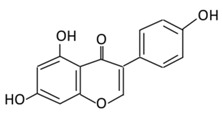
|
Soybeans, kudzu, and fava bean |
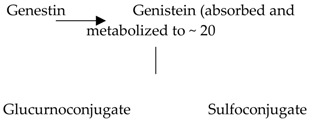
|
(A) Antihyperglycmeic effect: (B) Hypolipemic effect |
Reduce hyperglycemia through the activity of cAMP/ PKA pathway Decrease Intercellular Adhesion Molecule 1 (ICAM-1) and p-ERK Inhibit the activity of tyrosine kinase Improve glucose intolerance and β-cells mass Decrease urinary excretion of TBARs |
Streptozotocin (STZ)-induced diabetic rats Obese diabetic mice Nongenetictype 2 diabetic mice |
INS-1 cells Human islet β-cells |
[195,199] |
| 18. Daidzein |
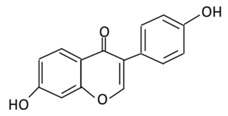
|
Soybeans, nuts, and soy milk | (A) Daidzin | (A) Antihyperglycmeic effect: | Decrease blood glucose, total cholesterol, and AMPK phosphorylation | Golden Syrian hamsters | [202,204] | ||
| Anthocyanins | 19. Cyanidin |
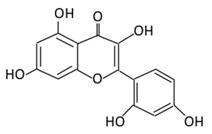
|
Bilberry, blueberry, grapes, blackberries, hawthorn, acai berry, and raspberry | (A) Anthocyanidin glucuronide conjugates (Major form in urine) (B) Simple Aglycones (Second major in urine) (C) Anthocyanidin methyl glucuronide conjugates (8 forms) (D) Cyanidin-3-glucoside E) Cyanidin-3-galactoside |
(A) Antihyperglycmeic effect: (B) Hypolipemic effect: |
Inhibit α-glucosidase and α-amylase which reduce the absorption of glucose in small intestine Reduce fasting glucose level Prevent pancreatic apoptosis Improve antioxidant status which protects hepatocytes from HG-induced damage Attenuate aortic lipid peroxidation |
Streptozotocin (STZ)-induced diabetic rats db/db rats high fat diet fed mice |
Mouse hepatocyte | [207,209] |
| 20.Delphinidin |
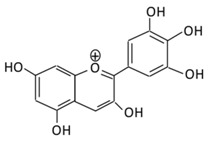
|
Dark grapes, eggplant, berries, red cabbage, carrot, and tomato | (A) 4′-O- methyl delphinidin 3-O-beta-d- glucopyranoside | (A) Antihyperglycmeic effect: |
Reduce the glycation rate of HbA1c Prevents diabetes associated injuries such as endothelial cell function |
Diabetic mouse | [213,215] | ||
| 21.Pelargonidin |
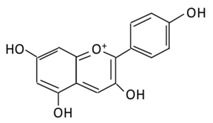
|
Bilberry and ficus bengalensis Linn | (A) Pelargonidin-O-glucuronide (B) Pelargonidin-3-galactoside |
(A) Antihyperglycmeic effect: (B) Hypolipemic effect: |
Reduce hyperglycemia Reduce the level of antioxidant defensive enzymes Stimulate insulin secretion Reduce the level of TBARS which is a byproduct of lipid peroxidation |
Streptozotocin (STZ)-induced diabetic rats Diabetic rats |
[217,219] | ||
2.5.2. Delphinidin
A flavonoid, delphinidin, is profusely found in pigmented vegetables and fruits, like berries, sweet potato, red cabbage, tomato, eggplant, carrots, red onion, and grapes [210]. It possesses anti-inflammatory, antioxidant, anti-mutagenic, and anti-angiogenic activities [211]. In an in vivo study, delphinidin showed to prevent endothelial cell function injuries associated with diabetes [212]. The administration of 100 mg/kg delphinidin to diabetic mice showed a decrease in HbA1c glycation and the rate of albumin [213]. Delphinidin and cyanidin were reported to reduce inflammation and regulate redox signaling pathways by ameliorating insulin resistance in high fat-fed mice [214]. The antidiabetic effects of delphinidin are due to their ability to reduce glucose uptake in mice jejunal tissue and human intestinal cells lines through free fatty acid receptor 1 (also named GPR40) [215].
2.5.3. Pelargonidin
A flavonoid, pelargonidin, is abundantly found in berries, like blueberries, cranberries, and raspberries [216]. The treatment with pelargonidin helps reduce hyperglycemia and oxidative stress levels [217]. In diabetic rats, pelargonidin showed it reduces the formation of thiobarbituric acid reactive substances (TBARS) and antioxidant defensive enzymes levels [218]. In an in vitro study, pelargonidin and its aglycone, pelargonidin-3-galactoside, stimulated insulin secretion [219].
3. Challenges Using Flavonoids
Flavonoids have been proven to be strong candidates to reduce the pathogenesis of diabetes and its complications. The modulatory anti-diabetic effects of flavonoids reduce apoptosis and insulin resistance and enhance insulin secretion and GLUT 4 translocation.
3.1. Estimated Consumption Level of Flavonoids
Flavonoids derived from vegetables and fruits are consumed in low quantities. Moreover, the content of vegetables and fruits contain not only flavonoids, but also a mixture of secondary plant metabolites. Therefore, it is difficult to stimulate this mixture into a simple purified dietary supplement [220,221]. Efforts have been made to establish an optimal human dietary consumption level of flavonoids worldwide, but the estimate methods used were poorly established [222]. A U.S. study on 805 men aged 65–84 years reported that the estimate intake of flavonoids from quercetin, myricetin, kaempferol, apigenin, and leuteolin was 26 mg/d and the major sources of intake were in apples, tea, and onions [223]. Another study conducted in the Netherlands reported a two-times higher the level of flavonoids consumed in adults compared to the U.S. study (50 g/day) [224]. In addition, two Dutch studies reported the estimated consumption level of flavonoids to be 23 mg/day and 26 mg/day respectively [225,226]. These differences observed in the consumption level of flavonoids depend on dietary habits, geographical location, socioeconomic status, food processing and preparation method, solubility of flavonoids, and the ethnicity of the population. For example, in Japan, soy containing food is highly consumed and, as a result the intake of isoflavone is higher than other flavonoids subclasses [106]. A study reported that orange juice contains 81–200mg/L of soluble flavanones compared to 206–644 mg/L seen in the cloud which clearly suggest that processing and storage affects the concentration of flavonoids [227].
To date, no recommended dosage of flavonoids has been reported due to the heterogeneity of their molecular structure and the limited information about their bioavailability. Major advances in understanding flavonoids bioavailability have been made, but the challenge to overcome problems, such as cellular permeability, solubility, excretion, and metabolic alternation, are still lacking. Research groups are trying to enhance flavonoids bioavailability by targeting absorption sites, improving metabolic stability and intestinal absorption [50].
3.1.1. Possible Side Effects of Flavonoids Consumption
Flavonoids in bacterial and mammalian experimental studies using Ames test indicated possible genotoxicity and mutagenicity of flavonoids if consumed at higher concentrations (ranges from 12.1 nmol to 225.0 nmol) [228]. Furthermore, it may alter amino acid, drug metabolism and the activity of key metabolizing enzymes [229]. Quercetin, a predominant flavonol in the human diet, showed a mutagenic effect by altering base-pair substitution and frame-shift mutation [230]. The isolated nuclei from liver rats treated with morin and naringenin showed an increase in reactive oxygen species, like hydroxyl radicals that lead to DNA degradation [231]. Additionally, flavonoids exert a cytotoxic activity as a topoisomerase II inhibitor. Genistein and quercetin are identified as topoisomerase II inhibitors, even at low concentrations (10 μM), where they accumulate cleavable complexes seen in patients with secondary leukemia [232]. Genistein, naringenin, kaempferol, and daidzein were reported to inhibit thyroxine synthesis by irreversibly inhibiting thyroid peroxidation [233].
Although no data are available to state the long-term side effects of increased flavonoid consumption, following an Asian diet that contains 68 mg of flavonol and 20–240 mg of isoflavone could improve thyroid function, reduce breast cancer mortality, and should not cause adverse health effects [234].
The concentrations needed for most flavonoids to generate mutagenic and cytotoxic side effects are unlikely to occur through dietary sources, but with supplementation, it could result in an increased toxic level. For instance, the recommended dosage of quercetin supplements is between 500 mg/day and 1000 mg/day, which is 20 times higher with what could be consumed in a vegetarian diet [235].
3.1.2. Could Flavonoid Combinations have synergistic effects?
While the amounts of flavonoids consumed is crucial to establish positive effects but also to avoid negative effects, the tables list some flavonoids that trigger multiple selected pathways improving the pathogenesis of diabetes (Figure 3, Table 1, Table 2, Table 3 and Table 4). The better activity can be defined by the number of diabetes related pathways which are improved through the consumption of different flavonoids. The administration of baicalein triggers four pathways: The suppression in the NF-κB pathway and fatty acid synthesis; the activation in hexokinase activity in the liver; and the protection against cell apoptosis. Quercetin prompts the activity of three different pathways: It improves GLUT 4 translocation; inhibits tyrosine kinase activity; and reduces lipid peroxidation. β-cells apoptosis could be prevented by the administration of cyanidin or kaempferol, or baicalein. The consumption of rutin or cyanidin inhibits α-glucosidase and α-amylase which reduce carbohydrate absorption in the small intestine (Table 4).
Could their positive effects on diabetes be further improved by ingesting a combination of different flavonoids which complement each other by triggering additional pathways? For example, the administration of baicalein and quercetin initiates the positive effects on diabetes in six major pathways: The glucose transporter; hepatic enzymes; beta cells apoptosis; PPARs; AMPK; tyrosine kinase; and NF-κB pathways. As a result of this hypothesized combination, the over activation of these pathways may be prevented, while the needed action to improve diabetes may be achieved. At this time, these are no more than suggestions which need to be proven by research. To date, little is known about flavonoids to flavonoids interactions [235]. In addition, some flavonoids showed an opposite effect on the same pathway and both lead to the improvement of diabetes. For example, fisetin has an inhibitory effect, while morin has a stimulatory effect on glucose 6 phosphate dehydrogenase and the literature states that they both improve diabetes (Figure 1). Extensive studies are required to understand the reasons behind this action—is it because of different binding sites, bioavailability, tissue exposure, absorption, or circulating concentration of these compounds. A similar pattern with different flavonoids was observed with PPAR and NF-κB pathways (Table 1, Table 2, Table 3 and Table 4).
3.1.3. Flavonoids and Metformin
Metformin is an oral anti-diabetic drug derived from the French lilac suitable for the treatment of diabetes with a well-known safety profile [236]. Comparing the effect of metformin and anthocyanins extracted from blueberries on blood glucose levels revealed that blueberry extract (595 mg/g total anthocyanins) led to a 33% to 51% reduction in blood glucose compared to 27% reduction seen with metformin [237]. Another study reported that quercetin stimulates an insulin dependent AMPK pathway, which is analogues to metformin activity [15]. In addition, a study which measured the effect of the co-treatment of metformin and flavone on breast cancer patients showed a significant inhibition in cell viability and an increase in apoptosis [238].
3.1.4. Flavonoids for the Treatment of Cancer
Phytochemicals are successfully used in the treatment of various cancers by modulating apoptotic pathways through: Reactive oxygen species (ROS) elevation; DNA damage induction; and apoptotic protein activation as clearly discussed in Abotaleb et al., 2018 [50]. Although flavonoids target and improve both the intrinsic and extrinsic apoptotic protein in cancer, they solely target the intrinsic pathway (Figure 3). Quercetin has similar beneficial effects on cancer and diabetes by inhibiting PI3K pathway [239]. The administration of luteolin targeting the NF-κB pathway showed an inhibitory effect on cancer, while a stimulatory effect on diabetes [240].
3.2. Final Thoughts
Flavonoids, abundantly found in fruits and vegetables, have mostly beneficial effects on diabetes. Eating vegetables and fruits could help to lower blood sugar levels and to decrease the chance to develop diabetes. Generally, it is possible that their combination with other phytochemicals could enhance the anti-diabetic effects, but more research is needed to support this promising way to reduce blood sugar levels.
Abbreviations
| DM | diabetes mellitus |
| GLUT | glucose transporter |
| HMIT | myo-inositol transporter |
| IRS | insulin resistance substrate |
| IR | insulin receptor |
| PTP | protein tyrosine phosphatase |
| PTEN | tensin homologue |
| FFAs | free fatty acids |
| TNF | tumor necrosis factor |
| SOCS | suppressor of cytokine signaling |
| IAPP | islet amyloid polypeptide |
| ER | endoplasmic reticulum |
| PPAR | peroxisome proliferator activated receptor |
| AMPK | adenosine monophosphate activated protein kinase |
| PI3K | Phosphoinositide 3-kinases |
| STZ | streptozotocin |
| NF-κB | nuclear Factor kappa-light-chain-enhancer of activated B cells |
| Bcl-2 | B-cell lymphoma 2 |
| HbA1c | hemoglobin A1C (glycated hemoglobin) |
| NO | nitric oxide |
| G6PD | glucose-6-phosphate dehydrogenase |
| G6Pase | glucose 6-phosphatase |
| HOMA-IR | homeostatic model assessment of insulin resistance |
| FDPase | fructose-1,6-diphosphatase |
| Msft | micro-autologous fat transplantation |
| IL-6 | Interleukin 6 |
| DN | diabetic neuropathy |
| GPx | glutathione peroxidase |
| HFD | high fat diet |
| AGEs | Advanced glycation end product |
| PKA | protein kinase A |
| NOD | non-obese diabetic |
| C3G | cyanidin-3-glucoside |
| HG | high glucose |
| TBARS | thiobarbituric acid reactive substances |
| ROS | reactive oxygen species |
| TC | total cholesterol |
| LDL | light density lipoprotein |
| TG | triglyceride |
| CAT | computerized axial tomography |
| MDA | muscular dystrophy association |
| RPTEC | renal proximal tubule epithelial cells |
| NRK-52E | rat kidney epithelial cells |
Author Contributions
Conceptualization, R.K.A.-I. and D.B.; literature review and resources, R.K.A.-I., P.K.; writing—original draft preparation, R.K.A.-I.; writing—review and editing, M.A., P.K., K.K., D.B.; figure preparation and editing, R.K.A.-I., D.B.; visualization, R.K.A.-I., M.A., and D.B.; supervision, D.B.; project administration, D.B.; funding acquisition, D.B.; All authors reviewed the results and approved the final version of the manuscript.
Funding
The review was funded by NPRP 11S-1214-170101 to D.B.
Conflicts of Interest
The authors declare no conflicts of interest.
References
- 1.Chen L., Magliano D.J., Zimmet P.Z. The worldwide epidemiology of type 2 diabetes mellitus-present and future perspectives. Nat. Rev. Endocrinol. 2011;8:228–236. doi: 10.1038/nrendo.2011.183. [DOI] [PubMed] [Google Scholar]
- 2.Danaei G., Finucane M.M., Lu Y., Singh G.M., Cowan M.J., Paciorek C.J. Global Burden of Metabolic Risk Factors of Chronic Diseases Collaborating, G. National, regional, and global trends in fasting plasma glucose and diabetes prevalence since 1980: Systematic analysis of health examination surveys and epidemiological studies with 370 country-years and 2.7 million participants. Lancet. 2011;378:31–40. doi: 10.1016/S0140-6736(11)60679-X. [DOI] [PubMed] [Google Scholar]
- 3.World Health Organization . Definition and Diagnosis of Diabetes Mellitus and Intermediate Hyperglycemia: Report of a WHO/IDF Consultation. World Health Organization; Geneva, Switherland: 2006. pp. 1–50. [Google Scholar]
- 4.Akkati S., Sam K.G., Tungha G. Emergence of promising therapies in diabetes mellitus. J. Clin. Pharmacol. 2011;51:796–804. doi: 10.1177/0091270010376972. [DOI] [PubMed] [Google Scholar]
- 5.Kharroubi A.T., Darwish H.M. Diabetes mellitus: The epidemic of the century. World J. Diabetes. 2015;6:850–867. doi: 10.4239/wjd.v6.i6.850. [DOI] [PMC free article] [PubMed] [Google Scholar]
- 6.Reyes J., Tripp-Reimer T., Parker E., Muller B., Laroche H. Factors Influencing Diabetes Self-Management Among Medically Underserved Patients with Type II Diabetes. Glob. Qual. Nurs. Res. 2017;4:2333393617713097. doi: 10.1177/2333393617713097. [DOI] [PMC free article] [PubMed] [Google Scholar]
- 7.Philippe J., Raccah D. Treating type 2 diabetes: How safe are current therapeutic agents? Int. J. Clin. Pract. 2009;63:321–332. doi: 10.1111/j.1742-1241.2008.01980.x. [DOI] [PubMed] [Google Scholar]
- 8.Chawla A., Chawla R., Jaggi S. Microvasular and macrovascular complications in diabetes mellitus: Distinct or continuum? Indian J. Endocrinol. Metab. 2016;20:546–551. doi: 10.4103/2230-8210.183480. [DOI] [PMC free article] [PubMed] [Google Scholar]
- 9.Muller L.M., Gorter K.J., Hak E., Goudzwaard W.L., Schellevis F.G., Hoepelman I.M., Rutten G.E. Increased risk of infection in patients with diabetes mellitus type 1 or 2. Ned. Tijdschr. Geneeskd. 2006;150:549–553. [PubMed] [Google Scholar]
- 10.Pareek H., Sharma S., Khajja B.S., Jain K., Jain G.C. Evaluation of hypoglycemic and anti-hyperglycemic potential of Tridax procumbens (Linn.) BMC Complement. Altern. Med. 2009;9:48. doi: 10.1186/1472-6882-9-48. [DOI] [PMC free article] [PubMed] [Google Scholar]
- 11.Hanhineva K., Torronen R., Bondia-Pons I., Pekkinen J., Kolehmainen M., Mykkanen H., Poutanen K. Impact of dietary polyphenols on carbohydrate metabolism. Int. J. Mol. Sci. 2010;11:1365–1402. doi: 10.3390/ijms11041365. [DOI] [PMC free article] [PubMed] [Google Scholar]
- 12.Skryhan K., Gurrieri L., Sparla F., Trost P., Blennow A. Redox Regulation of Starch Metabolism. Front. Plant Sci. 2018;9:1344. doi: 10.3389/fpls.2018.01344. [DOI] [PMC free article] [PubMed] [Google Scholar]
- 13.Mueckler M., Caruso C., Baldwin S.A., Panico M., Blench I., Morris H.R., Lodish H.F. Sequence and structure of a human glucose transporter. Science. 1985;229:941–945. doi: 10.1126/science.3839598. [DOI] [PubMed] [Google Scholar]
- 14.Mueckler M., Thorens B. The SLC2 (GLUT) family of membrane transporters. Mol. Asp. Med. 2013;34:121–138. doi: 10.1016/j.mam.2012.07.001. [DOI] [PMC free article] [PubMed] [Google Scholar]
- 15.Babu P.V., Liu D., Gilbert E.R. Recent advances in understanding the anti-diabetic actions of dietary flavonoids. J. Nutr. Biochem. 2013;24:1777–1789. doi: 10.1016/j.jnutbio.2013.06.003. [DOI] [PMC free article] [PubMed] [Google Scholar]
- 16.Wilcox G. Insulin and insulin resistance. Clin. Biochem. Rev. 2005;26:19–39. [PMC free article] [PubMed] [Google Scholar]
- 17.Burgering B.M., Coffer P.J. Protein kinase B (c-Akt) in phosphatidylinositol-3-OH kinase signal transduction. Nature. 1995;376:599–602. doi: 10.1038/376599a0. [DOI] [PubMed] [Google Scholar]
- 18.Dresner A., Laurent D., Marcucci M., Griffin M.E., Dufour S., Cline G.W., Shulman G.I. Effects of free fatty acids on glucose transport and IRS-1-associated phosphatidylinositol 3-kinase activity. J. Clin. Investig. 1999;103:253–259. doi: 10.1172/JCI5001. [DOI] [PMC free article] [PubMed] [Google Scholar]
- 19.Schinner S., Scherbaum W.A., Bornstein S.R., Barthel A. Molecular mechanisms of insulin resistance. Diabet. Med. 2005;22:674–682. doi: 10.1111/j.1464-5491.2005.01566.x. [DOI] [PubMed] [Google Scholar]
- 20.Aguirre V., Uchida T., Yenush L., Davis R., White M.F. The c-Jun NH(2)-terminal kinase promotes insulin resistance during association with insulin receptor substrate-1 and phosphorylation of Ser(307) J. Biol. Chem. 2000;275:9047–9054. doi: 10.1074/jbc.275.12.9047. [DOI] [PubMed] [Google Scholar]
- 21.Kile B.T., Schulman B.A., Alexander W.S., Nicola N.A., Martin H.M., Hilton D.J. The SOCS box: A tale of destruction and degradation. Trends Biochem. Sci. 2002;27:235–241. doi: 10.1016/S0968-0004(02)02085-6. [DOI] [PubMed] [Google Scholar]
- 22.Guillausseau P.J., Meas T., Virally M., Laloi-Michelin M., Medeau V., Kevorkian J.P. Abnormalities in insulin secretion in type 2 diabetes mellitus. Diabetes Metab. 2008;34:S43–S48. doi: 10.1016/S1262-3636(08)73394-9. [DOI] [PubMed] [Google Scholar]
- 23.Samuel V.T., Shulman G.I. The pathogenesis of insulin resistance: Integrating signaling pathways and substrate flux. J. Clin. Investig. 2016;126:12–22. doi: 10.1172/JCI77812. [DOI] [PMC free article] [PubMed] [Google Scholar]
- 24.Cernea S., Dobreanu M. Diabetes and beta cell function: From mechanisms to evaluation and clinical implications. Biochem. Med. (Zagreb) 2013;23:266–280. doi: 10.11613/BM.2013.033. [DOI] [PMC free article] [PubMed] [Google Scholar]
- 25.Del Prato S. Role of glucotoxicity and lipotoxicity in the pathophysiology of Type 2 diabetes mellitus and emerging treatment strategies. Diabet. Med. 2009;26:1185–1192. doi: 10.1111/j.1464-5491.2009.02847.x. [DOI] [PubMed] [Google Scholar]
- 26.Szoke E., Gerich J.E. Role of impaired insulin secretion and insulin resistance in the pathogenesis of type 2 diabetes mellitus. Compr. Ther. 2005;31:106–112. doi: 10.1007/s12019-005-0005-y. [DOI] [PubMed] [Google Scholar]
- 27.Yan L.J. Pathogenesis of chronic hyperglycemia: From reductive stress to oxidative stress. J. Diabetes Res. 2014:137919. doi: 10.1155/2014/137919. [DOI] [PMC free article] [PubMed] [Google Scholar]
- 28.Cnop M., Welsh N., Jonas J.C., Jorns A., Lenzen S., Eizirik D.L. Mechanisms of pancreatic beta-cell death in type 1 and type 2 diabetes: Many differences, few similarities. Diabetes. 2005;54:S97–S107. doi: 10.2337/diabetes.54.suppl_2.S97. [DOI] [PubMed] [Google Scholar]
- 29.Ameer F., Scandiuzzi L., Hasnain S., Kalbacher H., Zaidi N. De novo lipogenesis in health and disease. Metabolism. 2014;63:895–902. doi: 10.1016/j.metabol.2014.04.003. [DOI] [PubMed] [Google Scholar]
- 30.Tyagi S., Gupta P., Saini A.S., Kaushal C., Sharma S. The peroxisome proliferator-activated receptor: A family of nuclear receptors role in various diseases. J. Adv. Pharm. Technol. Res. 2011;2:236–240. doi: 10.4103/2231-4040.90879. [DOI] [PMC free article] [PubMed] [Google Scholar]
- 31.Furuhashi M., Hotamisligil G.S. Fatty acid-binding proteins: Role in metabolic diseases and potential as drug targets. Nat. Rev. Drug Discov. 2008;7:489–503. doi: 10.1038/nrd2589. [DOI] [PMC free article] [PubMed] [Google Scholar]
- 32.Makki K., Froguel P., Wolowczuk I. Adipose tissue in obesity-related inflammation and insulin resistance: Cells, cytokines, and chemokines. ISRN Inflamm. 2013:139239. doi: 10.1155/2013/139239. [DOI] [PMC free article] [PubMed] [Google Scholar]
- 33.Moon H.S., Dalamaga M., Kim S.Y., Polyzos S.A., Hamnvik O.P., Magkos F., Mantzoros C.S. Leptin’s role in lipodystrophic and nonlipodystrophic insulin-resistant and diabetic individuals. Endocr Rev. 2013;34:377–412. doi: 10.1210/er.2012-1053. [DOI] [PMC free article] [PubMed] [Google Scholar]
- 34.Jung U.J., Choi M.S. Obesity and its metabolic complications: The role of adipokines and the relationship between obesity, inflammation, insulin resistance, dyslipidemia and nonalcoholic fatty liver disease. Int. J. Mol. Sci. 2014;15:6184–6223. doi: 10.3390/ijms15046184. [DOI] [PMC free article] [PubMed] [Google Scholar]
- 35.American Diabetes Assossiation Standards of medical care in diabetes–2011. Diabetes Care. 2011;34:S11–S61. doi: 10.2337/dc11-S011. [DOI] [PMC free article] [PubMed] [Google Scholar]
- 36.McCrimmon R.J., Sherwin R.S. Hypoglycemia in type 1 diabetes. Diabetes. 2010;59:2333–2339. doi: 10.2337/db10-0103. [DOI] [PMC free article] [PubMed] [Google Scholar]
- 37.Paulweber B., Valensi P., Lindstrom J., Lalic N.M., Greaves C.J., McKee M., Yilmaz T. A European evidence-based guideline for the prevention of type 2 diabetes. Horm. Metab. Res. 2010;42:S3–S36. doi: 10.1055/s-0029-1240928. [DOI] [PubMed] [Google Scholar]
- 38.Bodmer M., Meier C., Krahenbuhl S., Jick S.S., Meier C.R. Metformin, sulfonylureas, or other antidiabetes drugs and the risk of lactic acidosis or hypoglycemia: A nested case-control analysis. Diabetes Care. 2008;31:2086–2091. doi: 10.2337/dc08-1171. [DOI] [PMC free article] [PubMed] [Google Scholar]
- 39.Catalan V.S., Couture J.A., LeLorier J. Predictors of persistence of use of the novel antidiabetic agent acarbose. Arch. Intern. Med. 2001;161:1106–1112. doi: 10.1001/archinte.161.8.1106. [DOI] [PubMed] [Google Scholar]
- 40.Klip A., Marette A., Dimitrakoudis D., Ramlal T., Giacca A., Shi Z.Q., Vranic M. Effect of diabetes on glucoregulation. From glucose transporters to glucose metabolism in vivo. Diabetes Care. 1992;15:1747–1766. doi: 10.2337/diacare.15.11.1747. [DOI] [PubMed] [Google Scholar]
- 41.Karnieli E., Armoni M. Regulation of glucose transporters in diabetes. Horm. Res. 1990;33:99–104. doi: 10.1159/000181491. [DOI] [PubMed] [Google Scholar]
- 42.Saligram S., Williams E.J., Masding M.G. Raised liver enzymes in newly diagnosed Type 2 diabetes are associated with weight and lipids, but not glycaemic control. Indian J. Endocrinol. Metab. 2012;16:1012–1014. doi: 10.4103/2230-8210.103027. [DOI] [PMC free article] [PubMed] [Google Scholar]
- 43.Forlani G., Di Bonito P., Mannucci E., Capaldo B., Genovese S., Orrasch M., Marchesini G. Prevalence of elevated liver enzymes in Type 2 diabetes mellitus and its association with the metabolic syndrome. J. Endocrinol. Investig. 2008;31:146–152. doi: 10.1007/BF03345581. [DOI] [PubMed] [Google Scholar]
- 44.Rangwala S.M., Lazar M.A. Peroxisome proliferator-activated receptor gamma in diabetes and metabolism. Trends Pharmacol. Sci. 2004;25:331–336. doi: 10.1016/j.tips.2004.03.012. [DOI] [PubMed] [Google Scholar]
- 45.Krijnen P.A., Simsek S., Niessen H.W. Apoptosis in diabetes. Apoptosis. 2009;14:1387–1388. doi: 10.1007/s10495-009-0419-6. [DOI] [PMC free article] [PubMed] [Google Scholar]
- 46.Leonidas D.D., Hayes J.M., Kato A., Skamnaki V.T., Chatzileontiadou D.S., Kantsadi A.L., Stravodimos G.A. Phytogenic Polyphenols as Glycogen Phosphorylase Inhibitors: The Potential of Triterpenes and Flavonoids for Glycaemic Control in Type 2 Diabetes. Curr. Med. Chem. 2017;24:384–403. doi: 10.2174/0929867324666161118122534. [DOI] [PubMed] [Google Scholar]
- 47.Ong K.C., Khoo H.E. Effects of myricetin on glycemia and glycogen metabolism in diabetic rats. Life Sci. 2000;67:1695–1705. doi: 10.1016/S0024-3205(00)00758-X. [DOI] [PubMed] [Google Scholar]
- 48.Ahmad M., Akhtar M.S., Malik T., Gilani A.H. Hypoglycaemic action of the flavonoid fraction of Cuminum nigrum seeds. Phytother. Res. 2000;14:103–106. doi: 10.1002/(SICI)1099-1573(200003)14:2<103::AID-PTR578>3.0.CO;2-P. [DOI] [PubMed] [Google Scholar]
- 49.Cushnie T.P., Lamb A.J. Antimicrobial activity of flavonoids. Int. J. Antimicrob. Agents. 2005;26:343–356. doi: 10.1016/j.ijantimicag.2005.09.002. [DOI] [PMC free article] [PubMed] [Google Scholar]
- 50.Abotaleb M., Samuel S.M., Varghese E., Varghese S., Kubatka P., Liskova A., Busselberg D. Flavonoids in Cancer and Apoptosis. Cancers (Basel) 2018;11:28. doi: 10.3390/cancers11010028. [DOI] [PMC free article] [PubMed] [Google Scholar]
- 51.Beecher G.R. Overview of dietary flavonoids: Nomenclature, occurrence and intake. J. Nutr. 2003;133:3248S–3254S. doi: 10.1093/jn/133.10.3248S. [DOI] [PubMed] [Google Scholar]
- 52.Scalbert A., Williamson G. Dietary intake and bioavailability of polyphenols. J. Nutr. 2000;130:2073S–2085S. doi: 10.1093/jn/130.8.2073S. [DOI] [PubMed] [Google Scholar]
- 53.Middleton E., Kandaswami C., Jr., Theoharides T.C. The effects of plant flavonoids on mammalian cells: Implications for inflammation, heart disease, and cancer. Pharmacol. Rev. 2000;52:673–751. [PubMed] [Google Scholar]
- 54.Hossain M.K., Choi H.Y., Hwang J.S., Dayem A.A., Kim J.H., Kim Y.B., Cho S.G. Antiviral activity of 3,4′-dihydroxyflavone on influenza a virus. J. Microbiol. 2014;52:521–526. doi: 10.1007/s12275-014-4212-z. [DOI] [PubMed] [Google Scholar]
- 55.Kawser Hossain M., Abdal Dayem A., Han J., Yin Y., Kim K., Kumar Saha S., Cho S.G. Molecular Mechanisms of the Anti-Obesity and Anti-Diabetic Properties of Flavonoids. Int. J. Mol. Sci. 2016;17:569. doi: 10.3390/ijms17040569. [DOI] [PMC free article] [PubMed] [Google Scholar]
- 56.Vinayagam R., Xu B. Antidiabetic properties of dietary flavonoids: A cellular mechanism review. Nutr. Metab. (Lond.) 2015;12:60. doi: 10.1186/s12986-015-0057-7. [DOI] [PMC free article] [PubMed] [Google Scholar]
- 57.Graf B.A., Milbury P.E., Blumberg J.B. Flavonols, flavones, flavanones, and human health: Epidemiological evidence. J. Med. Food. 2005;8:281–290. doi: 10.1089/jmf.2005.8.281. [DOI] [PubMed] [Google Scholar]
- 58.Wedick N.M., Pan A., Cassidy A., Rimm E.B., Sampson L., Rosner B., van Dam R.M. Dietary flavonoid intakes and risk of type 2 diabetes in US men and women. Am. J. Clin. Nutr. 2012;95:925–933. doi: 10.3945/ajcn.111.028894. [DOI] [PMC free article] [PubMed] [Google Scholar]
- 59.Barone E., Calabrese V., Mancuso C. Ferulic acid and its therapeutic potential as a hormetin for age-related diseases. Biogerontology. 2009;10:97–108. doi: 10.1007/s10522-008-9160-8. [DOI] [PubMed] [Google Scholar]
- 60.Tanveer A., Akram K., Farooq U., Hayat Z., Shafi A. Management of diabetic complications through fruit flavonoids as a natural remedy. Crit. Rev. Food Sci. Nutr. 2017;57:1411–1422. doi: 10.1080/10408398.2014.1000482. [DOI] [PubMed] [Google Scholar]
- 61.Del Rio D., Calani L., Scazzina F., Jechiu L., Cordero C., Brighenti F. Bioavailability of catechins from ready-to-drink tea. Nutrition. 2010;26:528–533. doi: 10.1016/j.nut.2009.06.013. [DOI] [PubMed] [Google Scholar]
- 62.Scalbert A., Morand C., Manach C., Remesy C. Absorption and metabolism of polyphenols in the gut and impact on health. Biomed. Pharmacother. 2002;56:276–282. doi: 10.1016/S0753-3322(02)00205-6. [DOI] [PubMed] [Google Scholar]
- 63.Spencer J.P., Schroeter H., Rechner A.R., Rice-Evans C. Bioavailability of flavan-3-ols and procyanidins: Gastrointestinal tract influences and their relevance to bioactive forms in vivo. Antioxid. Redox Signal. 2001;3:1023–1039. doi: 10.1089/152308601317203558. [DOI] [PubMed] [Google Scholar]
- 64.Panche A.N., Diwan A.D., Chandra S.R. Flavonoids: An overview. J. Nutr. Sci. 2016;5:e47. doi: 10.1017/jns.2016.41. [DOI] [PMC free article] [PubMed] [Google Scholar]
- 65.Kelly G.S. Quercetin. Monograph. Altern. Med. Rev. 2011;16:172–194. [PubMed] [Google Scholar]
- 66.Anand David A.V., Arulmoli R., Parasuraman S. Overviews of Biological Importance of Quercetin: A Bioactive Flavonoid. Pharmacogn. Rev. 2016;10:84–89. doi: 10.4103/0973-7847.194044. [DOI] [PMC free article] [PubMed] [Google Scholar]
- 67.Hollman P.C., de Vries J.H., van Leeuwen S.D., Mengelers M.J., Katan M.B. Absorption of dietary quercetin glycosides and quercetin in healthy ileostomy volunteers. Am. J. Clin. Nutr. 1995;62:1276–1282. doi: 10.1093/ajcn/62.6.1276. [DOI] [PubMed] [Google Scholar]
- 68.Eid H.M., Haddad P.S. The Antidiabetic Potential of Quercetin: Underlying Mechanisms. Curr. Med. Chem. 2017;24:355–364. doi: 10.2174/0929867323666160909153707. [DOI] [PubMed] [Google Scholar]
- 69.Yao Z., Gu Y., Zhang Q., Liu L., Meng G., Wu H., Xia Y., Bao X., Shi H., Sun S., et al. Estimated daily quercetin intake and association with the prevalence of type 2 diabetes mellitus in Chinese adults. Eur. J. Nutr. 2019;58:819–830. doi: 10.1007/s00394-018-1713-2. [DOI] [PubMed] [Google Scholar]
- 70.Fang X.K., Gao J., Zhu D.N. Kaempferol and quercetin isolated from Euonymus alatus improve glucose uptake of 3T3-L1 cells without adipogenesis activity. Life Sci. 2008;82:615–622. doi: 10.1016/j.lfs.2007.12.021. [DOI] [PubMed] [Google Scholar]
- 71.Bule M., Abdurahman A., Nikfar S., Abdollahi M., Amini M. Antidiabetic effect of quercetin: A systematic review and meta-analysis of animal studies. Food Chem. Toxicol. 2019;125:494–502. doi: 10.1016/j.fct.2019.01.037. [DOI] [PubMed] [Google Scholar]
- 72.Eid H.M., Martineau L.C., Saleem A., Muhammad A., Vallerand D., Benhaddou-Andaloussi A., Haddad P.S. Stimulation of AMP-activated protein kinase and enhancement of basal glucose uptake in muscle cells by quercetin and quercetin glycosides, active principles of the antidiabetic medicinal plant Vaccinium vitis-idaea. Mol. Nutr. Food Res. 2010;54:991–1003. doi: 10.1002/mnfr.200900218. [DOI] [PubMed] [Google Scholar]
- 73.Coskun O., Kanter M., Korkmaz A., Oter S. Quercetin, a flavonoid antioxidant, prevents and protects streptozotocin-induced oxidative stress and beta-cell damage in rat pancreas. Pharmacol. Res. 2005;51:117–123. doi: 10.1016/j.phrs.2004.06.002. [DOI] [PubMed] [Google Scholar]
- 74.Stewart L.K., Wang Z., Ribnicky D., Soileau J.L., Cefalu W.T., Gettys T.W. Failure of dietary quercetin to alter the temporal progression of insulin resistance among tissues of C57BL/6J mice during the development of diet-induced obesity. Diabetologia. 2009;52:514–523. doi: 10.1007/s00125-008-1252-0. [DOI] [PMC free article] [PubMed] [Google Scholar]
- 75.Alam M.M., Meerza D., Naseem I. Protective effect of quercetin on hyperglycemia, oxidative stress and DNA damage in alloxan induced type 2 diabetic mice. Life Sci. 2014;109:8–14. doi: 10.1016/j.lfs.2014.06.005. [DOI] [PubMed] [Google Scholar]
- 76.Kobori M., Masumoto S., Akimoto Y., Takahashi Y. Dietary quercetin alleviates diabetic symptoms and reduces streptozotocin-induced disturbance of hepatic gene expression in mice. Mol. Nutr. Food Res. 2009;53:859–868. doi: 10.1002/mnfr.200800310. [DOI] [PubMed] [Google Scholar]
- 77.Vessal M., Hemmati M., Vasei M. Antidiabetic effects of quercetin in streptozocin-induced diabetic rats. Comp. Biochem. Physiol. 2003;135C:357–364. doi: 10.1016/S1532-0456(03)00140-6. [DOI] [PubMed] [Google Scholar]
- 78.Eid H.M., Nachar A., Thong F., Sweeney G., Haddad P.S. The molecular basis of the antidiabetic action of quercetin in cultured skeletal muscle cells and hepatocytes. Pharmacogn. Mag. 2015;11:74–81. doi: 10.4103/0973-1296.149708. [DOI] [PMC free article] [PubMed] [Google Scholar]
- 79.Eitah H.E., Maklad Y.A., Abdelkader N.F., Gamal El Din A.A., Badawi M.A., Kenawy S.A. Modulating impacts of quercetin/sitagliptin combination on streptozotocin-induced diabetes mellitus in rats. Toxicol. Appl. Pharmacol. 2019;365:30–40. doi: 10.1016/j.taap.2018.12.011. [DOI] [PubMed] [Google Scholar]
- 80.Dai X., Ding Y., Zhang Z., Cai X., Li Y. Quercetin and quercitrin protect against cytokineinduced injuries in RINm5F beta-cells via the mitochondrial pathway and NF-kappaB signaling. Int. J. Mol. Med. 2013;31:265–271. doi: 10.3892/ijmm.2012.1177. [DOI] [PubMed] [Google Scholar]
- 81.Kreft S., Knapp M., Kreft I. Extraction of rutin from buckwheat (Fagopyrum esculentumMoench) seeds and determination by capillary electrophoresis. J. Agric. Food Chem. 1999;47:4649–4652. doi: 10.1021/jf990186p. [DOI] [PubMed] [Google Scholar]
- 82.Huang W.Y., Zhang H.C., Liu W.X., Li C.Y. Survey of antioxidant capacity and phenolic composition of blueberry, blackberry, and strawberry in Nanjing. J. Zhejiang Univ. Sci. B. 2012;13:94–102. doi: 10.1631/jzus.B1100137. [DOI] [PMC free article] [PubMed] [Google Scholar]
- 83.Ghorbani A. Mechanisms of antidiabetic effects of flavonoid rutin. Biomed. Pharmacother. 2017;96:305–312. doi: 10.1016/j.biopha.2017.10.001. [DOI] [PubMed] [Google Scholar]
- 84.Stanley Mainzen Prince P., Kamalakkannan N. Rutin improves glucose homeostasis in streptozotocin diabetic tissues by altering glycolytic and gluconeogenic enzymes. J. Biochem. Mol. Toxicol. 2006;20:96–102. doi: 10.1002/jbt.20117. [DOI] [PubMed] [Google Scholar]
- 85.Niture N.T., Ansari A.A., Naik S.R. Anti-hyperglycemic activity of rutin in streptozotocin-induced diabetic rats: An effect mediated through cytokines, antioxidants and lipid biomarkers. Indian J. Exp. Biol. 2014;52:720–727. [PubMed] [Google Scholar]
- 86.Stanely Mainzen Prince P., Kannan N.K. Protective effect of rutin on lipids, lipoproteins, lipid metabolizing enzymes and glycoproteins in streptozotocin-induced diabetic rats. J. Pharm. Pharmacol. 2006;58:1373–1383. doi: 10.1211/jpp.58.10.0011. [DOI] [PubMed] [Google Scholar]
- 87.Hao H.H., Shao Z.M., Tang D.Q., Lu Q., Chen X., Yin X.X., Chen H. Preventive effects of rutin on the development of experimental diabetic nephropathy in rats. Life Sci. 2012;91:959–967. doi: 10.1016/j.lfs.2012.09.003. [DOI] [PubMed] [Google Scholar]
- 88.Ola M.S., Ahmed M.M., Ahmad R., Abuohashish H.M., Al-Rejaie S.S., Alhomida A.S. Neuroprotective Effects of Rutin in Streptozotocin-Induced Diabetic Rat Retina. J. Mol. Neurosci. 2015;56:440–448. doi: 10.1007/s12031-015-0561-2. [DOI] [PubMed] [Google Scholar]
- 89.Jadhav R., Puchchakayala G. Hypoglycemic and antidiabetic activity of flavonoids: Boswellic acid, Ellagic acid, Quercetin, Rutin on streptozotocin-nicotinamide induced type 2 diabetic rats. Int. J. Pharm. Pharm. Sci. 2012;4:251–256. [Google Scholar]
- 90.Calderon-Montano J.M., Burgos-Moron E., Perez-Guerrero C., Lopez-Lazaro M. A review on the dietary flavonoid kaempferol. Mini Rev. Med. Chem. 2011;11:298–344. doi: 10.2174/138955711795305335. [DOI] [PubMed] [Google Scholar]
- 91.Chen A.Y., Chen Y.C. A review of the dietary flavonoid, kaempferol on human health and cancer chemoprevention. Food Chem. 2013;138:2099–2107. doi: 10.1016/j.foodchem.2012.11.139. [DOI] [PMC free article] [PubMed] [Google Scholar]
- 92.An G., Gallegos J., Morris M.E. The bioflavonoid kaempferol is an Abcg2 substrate and inhibits Abcg2-mediated quercetin efflux. Drug Metab. Dispos. 2011;39:426–432. doi: 10.1124/dmd.110.035212. [DOI] [PubMed] [Google Scholar]
- 93.Jorge A.P., Horst H., de Sousa E., Pizzolatti M.G., Silva F.R. Insulinomimetic effects of kaempferitrin on glycaemia and on 14C-glucose uptake in rat soleus muscle. Chem. Biol. Interact. 2004;149:89–96. doi: 10.1016/j.cbi.2004.07.001. [DOI] [PubMed] [Google Scholar]
- 94.Zhang Z., Ding Y., Dai X., Wang J., Li Y. Epigallocatechin-3-gallate protects pro-inflammatory cytokine induced injuries in insulin-producing cells through the mitochondrial pathway. Eur. J. Pharmacol. 2011;670:311–316. doi: 10.1016/j.ejphar.2011.08.033. [DOI] [PubMed] [Google Scholar]
- 95.Zanatta L., Rosso A., Folador P., Figueiredo M.S., Pizzolatti M.G., Leite L.D., Silva F.R. Insulinomimetic effect of kaempferol 3-neohesperidoside on the rat soleus muscle. J. Nat. Prod. 2008;71:532–535. doi: 10.1021/np070358+. [DOI] [PubMed] [Google Scholar]
- 96.Zhang Y., Liu D. Flavonol kaempferol improves chronic hyperglycemia-impaired pancreatic beta-cell viability and insulin secretory function. Eur. J. Pharmacol. 2011;670:325–332. doi: 10.1016/j.ejphar.2011.08.011. [DOI] [PubMed] [Google Scholar]
- 97.Alkhalidy H., Moore W., Wang Y., Luo J., McMillan R.P., Zhen W., Zhou K., Liu D. The Flavonoid Kaempferol Ameliorates Streptozotocin-Induced Diabetes by Suppressing Hepatic Glucose Production. Molecules. 2018;23:2338. doi: 10.3390/molecules23092338. [DOI] [PMC free article] [PubMed] [Google Scholar]
- 98.Sharma D., Gondaliya P., Tiwari V., Kalia K. Kaempferol attenuates diabetic nephropathy by inhibiting RhoA/Rho-kinase mediated inflammatory signalling. Biomed. Pharmacother. 2019;109:1610–1619. doi: 10.1016/j.biopha.2018.10.195. [DOI] [PubMed] [Google Scholar]
- 99.Hung L.M., Chen J.K., Huang S.S., Lee R.S., Su M.J. Cardioprotective effect of resveratrol, a natural antioxidant derived from grapes. Cardiovasc. Res. 2000;47:549–555. doi: 10.1016/S0008-6363(00)00102-4. [DOI] [PubMed] [Google Scholar]
- 100.Atten M.J., Godoy-Romero E., Attar B.M., Milson T., Zopel M., Holian O. Resveratrol regulates cellular PKC alpha and delta to inhibit growth and induce apoptosis in gastric cancer cells. Investig. New Drugs. 2005;23:111–119. doi: 10.1007/s10637-005-5855-8. [DOI] [PubMed] [Google Scholar]
- 101.Yokozawa T., Kim H.Y., Cho E.J., Choi J.S., Chung H.Y. Antioxidant effects of isorhamnetin 3,7-di-O-beta-D-glucopyranoside isolated from mustard leaf (Brassica juncea) in rats with streptozotocin-induced diabetes. J. Agric. Food Chem. 2002;50:5490–5495. doi: 10.1021/jf0202133. [DOI] [PubMed] [Google Scholar]
- 102.Lee Y.S., Lee S., Lee H.S., Kim B.K., Ohuchi K., Shin K.H. Inhibitory effects of isorhamnetin-3-O-beta-D-glucoside from Salicornia herbacea on rat lens aldose reductase and sorbitol accumulation in streptozotocin-induced diabetic rat tissues. Biol. Pharm. Bull. 2005;28:916–918. doi: 10.1248/bpb.28.916. [DOI] [PubMed] [Google Scholar]
- 103.Rodriguez-Rodriguez C., Torres N., Gutierrez-Uribe J.A., Noriega L.G., Torre-Villalvazo I., Leal-Diaz A.M., Tovar A.R. The effect of isorhamnetin glycosides extracted from Opuntia ficus-indica in a mouse model of diet induced obesity. Food Funct. 2015;6:805–815. doi: 10.1039/C4FO01092B. [DOI] [PubMed] [Google Scholar]
- 104.Lee J., Jung E., Lee J., Kim S., Huh S., Kim Y., Park D. Isorhamnetin represses adipogenesis in 3T3-L1 cells. Obesity (Silver Spring) 2008;17:226–232. doi: 10.1038/oby.2008.472. [DOI] [PubMed] [Google Scholar]
- 105.Khan N., Syed D.N., Ahmad N., Mukhtar H. Fisetin: A dietary antioxidant for health promotion. ARS. 2013;19:151–162. doi: 10.1089/ars.2012.4901. [DOI] [PMC free article] [PubMed] [Google Scholar]
- 106.Arai Y., Watanabe S., Kimira M., Shimoi K., Mochizuki R., Kinae N. Dietary intakes of flavonols, flavones and isoflavones by Japanese women and the inverse correlation between quercetin intake and plasma LDL cholesterol concentration. J. Nutr. 2000;130:2243–2250. doi: 10.1093/jn/130.9.2243. [DOI] [PubMed] [Google Scholar]
- 107.Constantin R.P., Constantin J., Pagadigorria C.L., Ishii-Iwamoto E.L., Bracht A., Ono Mde K., Yamamoto N.S. The actions of fisetin on glucose metabolism in the rat liver. Cell Biochem. Funct. 2010;28:149–158. doi: 10.1002/cbf.1635. [DOI] [PubMed] [Google Scholar]
- 108.Prasath G.S., Pillai S.I., Subramanian S.P. Fisetin improves glucose homeostasis through the inhibition of gluconeogenic enzymes in hepatic tissues of streptozotocin induced diabetic rats. Eur. J. Pharmacol. 2014;740:248–254. doi: 10.1016/j.ejphar.2014.06.065. [DOI] [PubMed] [Google Scholar]
- 109.Prasath G.S., Sundaram C.S., Subramanian S.P. Fisetin averts oxidative stress in pancreatic tissues of streptozotocin-induced diabetic rats. Endocrine. 2013;44:359–368. doi: 10.1007/s12020-012-9866-x. [DOI] [PubMed] [Google Scholar]
- 110.Kim H.J., Kim S.H., Yun J.M. Fisetin inhibits hyperglycemia-induced proinflammatory cytokine production by epigenetic mechanisms. eCAM. 2012:639469. doi: 10.1155/2012/639469. [DOI] [PMC free article] [PubMed] [Google Scholar]
- 111.Prasath G.S., Subramanian S.P. Modulatory effects of fisetin, a bioflavonoid, on hyperglycemia by attenuating the key enzymes of carbohydrate metabolism in hepatic and renal tissues in streptozotocin-induced diabetic rats. Eur. J. Pharmacol. 2011;668:492–496. doi: 10.1016/j.ejphar.2011.07.021. [DOI] [PubMed] [Google Scholar]
- 112.Althunibat O.Y., Al Hroob A.M., Abukhalil M.H., Germoush M.O., Bin-Jumah M., Mahmoud A.M. Fisetin ameliorates oxidative stress, inflammation and apoptosis in diabetic cardiomyopathy. Life Sci. 2019;221:83–92. doi: 10.1016/j.lfs.2019.02.017. [DOI] [PubMed] [Google Scholar]
- 113.Sandireddy R., Yerra V.G., Komirishetti P., Areti A., Kumar A. Fisetin Imparts Neuroprotection in Experimental Diabetic Neuropathy by Modulating Nrf2 and NF-κB Pathways. Cell. Mol. Neurobiol. 2016;36:883–892. doi: 10.1007/s10571-015-0272-9. [DOI] [PMC free article] [PubMed] [Google Scholar]
- 114.Ricardo K.F.S., de Oliveira T.T., Jorge Nagem T.J., da Silva Pinto A., Oliveira M.G.A., Soares J.F. Effect of flavonoids morin; quercetin and nicotinic acid on lipid metabolism of rats experimentally fed with triton. Braz. Arch. Biol. Technol. 2001;44:263–267. doi: 10.1590/S1516-89132001000300007. [DOI] [Google Scholar]
- 115.Sreedharan V., Venkatachalam K.K., Namasivayam N. Effect of morin on tissue lipid peroxidation and antioxidant status in 1, 2-dimethylhydrazine induced experimental colon carcinogenesis. Investig. New Drugs. 2009;27:21–30. doi: 10.1007/s10637-008-9136-1. [DOI] [PubMed] [Google Scholar]
- 116.Sendrayaperumal V., Iyyam Pillai S., Subramanian S. Design, synthesis and characterization of zinc-morin, a metal flavonol complex and evaluation of its antidiabetic potential in HFD-STZ induced type 2 diabetes in rats. Chem. Biol. Interact. 2014;219:9–17. doi: 10.1016/j.cbi.2014.05.003. [DOI] [PubMed] [Google Scholar]
- 117.Abuohashish H.M., Al-Rejaie S.S., Al-Hosaini K.A., Parmar M.Y., Ahmed M.M. Alleviating effects of morin against experimentally-induced diabetic osteopenia. Diabetol. Metab. Syndr. 2013;5:5. doi: 10.1186/1758-5996-5-5. [DOI] [PMC free article] [PubMed] [Google Scholar]
- 118.Wang X., Zhang D.M., Gu T.T., Ding X.Q., Fan C.Y., Zhu Q., Kong L.D. Morin reduces hepatic inflammation-associated lipid accumulation in high fructose-fed rats via inhibiting sphingosine kinase 1/sphingosine 1-phosphate signaling pathway. Biochem. Pharmacol. 2013;86:1791–1804. doi: 10.1016/j.bcp.2013.10.005. [DOI] [PubMed] [Google Scholar]
- 119.Vanitha P., Uma C., Suganya N., Bhakkiyalakshmi E., Suriyanarayanan S., Gunasekaran P., Ramkumar K.M. Modulatory effects of morin on hyperglycemia by attenuating the hepatic key enzymes of carbohydrate metabolism and beta-cell function in streptozotocin-induced diabetic rats. Environ. Toxicol. Pharmacol. 2014;37:326–335. doi: 10.1016/j.etap.2013.11.017. [DOI] [PubMed] [Google Scholar]
- 120.Parhiz H., Roohbakhsh A., Soltani F., Rezaee R., Iranshahi M. Antioxidant and anti-inflammatory properties of the citrus flavonoids hesperidin and hesperetin: An updated review of their molecular mechanisms and experimental models. Phytother. Res. 2015;29:323–331. doi: 10.1002/ptr.5256. [DOI] [PubMed] [Google Scholar]
- 121.Visnagri A., Kandhare A.D., Chakravarty S., Ghosh P., Bodhankar S.L. Hesperidin, a flavanoglycone attenuates experimental diabetic neuropathy via modulation of cellular and biochemical marker to improve nerve functions. Pharm. Biol. 2014;52:814–828. doi: 10.3109/13880209.2013.870584. [DOI] [PubMed] [Google Scholar]
- 122.Jung U.J., Lee M.K., Jeong K.S., Choi M.S. The hypoglycemic effects of hesperidin and naringin are partly mediated by hepatic glucose-regulating enzymes in C57BL/KsJ-db/db mice. J. Nutr. 2004;134:2499–2503. doi: 10.1093/jn/134.10.2499. [DOI] [PubMed] [Google Scholar]
- 123.Jung U.J., Lee M.K., Park Y.B., Kang M.A., Choi M.S. Effect of citrus flavonoids on lipid metabolism and glucose-regulating enzyme mRNA levels in type-2 diabetic mice. Int. J. Biochem. Cell Biol. 2006;38:1134–1145. doi: 10.1016/j.biocel.2005.12.002. [DOI] [PubMed] [Google Scholar]
- 124.Agrawal Y.O., Sharma P.K., Shrivastava B., Ojha S., Upadhya H.M., Arya D.S., Goyal S.N. Hesperidin produces cardioprotective activity via PPAR-gamma pathway in ischemic heart disease model in diabetic rats. PLoS ONE. 2014;9:e111212. doi: 10.1371/journal.pone.0111212. [DOI] [PMC free article] [PubMed] [Google Scholar]
- 125.Akiyama S., Katsumata S., Suzuki K., Ishimi Y., Wu J., Uehara M. Dietary hesperidin exerts hypoglycemic and hypolipidemic effects in streptozotocin-induced marginal type 1 diabetic rats. J. Clin. Biochem. Nutr. 2010;46:87–92. doi: 10.3164/jcbn.09-82. [DOI] [PMC free article] [PubMed] [Google Scholar]
- 126.Akiyama S., Katsumata S., Suzuki K., Nakaya Y., Ishimi Y., Uehara M. Hypoglycemic and hypolipidemic effects of hesperidin and cyclodextrin-clathrated hesperetin in Goto-Kakizaki rats with type 2 diabetes. Biosci. Biotechnol. Biochem. 2009;73:2779–2782. doi: 10.1271/bbb.90576. [DOI] [PubMed] [Google Scholar]
- 127.Dokumacioglu E., Iskender H., Musmul A. Effect of hesperidin treatment on α-Klotho/FGF-23 pathway in rats with experimentally-induced diabetes. Biomed. Pharmacother. 2019;109:1206–1210. doi: 10.1016/j.biopha.2018.10.192. [DOI] [PubMed] [Google Scholar]
- 128.Hasanein P., Fazeli F. Role of naringenin in protection against diabetic hyperalgesia and tactile allodynia in male Wistar rats. J. Physiol. Biochem. 2014;70:997–1006. doi: 10.1007/s13105-014-0369-5. [DOI] [PubMed] [Google Scholar]
- 129.Patel K., Singh G.K., Patel D.K. A Review on Pharmacological and Analytical Aspects of Naringenin. Chin. J. Integr. Med. 2018;24:551–560. doi: 10.1007/s11655-014-1960-x. [DOI] [PubMed] [Google Scholar]
- 130.Zygmunt K., Faubert B., MacNeil J., Tsiani E. Naringenin, a citrus flavonoid, increases muscle cell glucose uptake via AMPK. Biochem. Biophys. Res. Commun. 2010;398:178–183. doi: 10.1016/j.bbrc.2010.06.048. [DOI] [PubMed] [Google Scholar]
- 131.van Acker F.A., Schouten O., Haenen G.R., van der Vijgh W.J., Bast A. Flavonoids can replace alpha-tocopherol as an antioxidant. FEBS Lett. 2000;473:145–148. doi: 10.1016/S0014-5793(00)01517-9. [DOI] [PubMed] [Google Scholar]
- 132.Priscilla D.H., Roy D., Suresh A., Kumar V., Thirumurugan K. Naringenin inhibits alpha-glucosidase activity: A promising strategy for the regulation of postprandial hyperglycemia in high fat diet fed streptozotocin induced diabetic rats. Chem. Biol. Interact. 2014;210:77–85. doi: 10.1016/j.cbi.2013.12.014. [DOI] [PubMed] [Google Scholar]
- 133.Pu P., Gao D.M., Mohamed S., Chen J., Zhang J., Zhou X.Y., Jiang H. Naringin ameliorates metabolic syndrome by activating AMP-activated protein kinase in mice fed a high-fat diet. Arch. Biochem. Biophys. 2012;518:61–70. doi: 10.1016/j.abb.2011.11.026. [DOI] [PubMed] [Google Scholar]
- 134.Singh A.K., Raj V., Keshari A.K., Rai A., Kumar P., Rawat A., Maity B., Kumar D., Prakash A., De A., et al. Isolated mangiferin and naringenin exert antidiabetic effect via PPARγ/GLUT4 dual agonistic action with strong metabolic regulation. Chem. Biol. Interact. 2018;280:33–44. doi: 10.1016/j.cbi.2017.12.007. [DOI] [PubMed] [Google Scholar]
- 135.Li J.M., Che C.T., Lau C.B., Leung P.S., Cheng C.H. Inhibition of intestinal and renal Na+-glucose cotransporter by naringenin. Int. J. Biochem. Cell Biol. 2006;38:985–995. doi: 10.1016/j.biocel.2005.10.002. [DOI] [PubMed] [Google Scholar]
- 136.Choi J.S., Yokozawa T., Oura H. Improvement of hyperglycemia and hyperlipemia in streptozotocin-diabetic rats by a methanolic extract of Prunus davidiana stems and its main component, prunin. Planta Med. 1991;57:208–211. doi: 10.1055/s-2006-960075. [DOI] [PubMed] [Google Scholar]
- 137.Kannappan S., Anuradha C.V. Naringenin enhances insulin-stimulated tyrosine phosphorylation and improves the cellular actions of insulin in a dietary model of metabolic syndrome. Eur. J. Nutr. 2010;49:101–109. doi: 10.1007/s00394-009-0054-6. [DOI] [PubMed] [Google Scholar]
- 138.Mulvihill E.E., Allister E.M., Sutherland B.G., Telford D.E., Sawyez C.G., Edwards J.Y., Huff M.W. Naringenin prevents dyslipidemia, apolipoprotein B overproduction, and hyperinsulinemia in LDL receptor-null mice with diet-induced insulin resistance. Diabetes. 2009;58:2198–2210. doi: 10.2337/db09-0634. [DOI] [PMC free article] [PubMed] [Google Scholar]
- 139.Annadurai T., Muralidharan A.R., Joseph T., Hsu M.J., Thomas P.A., Geraldine P. Antihyperglycemic and antioxidant effects of a flavanone, naringenin, in streptozotocin–nicotinamide-induced experimental diabetic rats. J. Physiol. Biochem. 2012;68:307–318. doi: 10.1007/s13105-011-0142-y. [DOI] [PubMed] [Google Scholar]
- 140.Al-Dosari D.I., Ahmed M.M., Al-Rejaie S.S., Alhomida A.S., Ola M.S. Flavonoid Naringenin Attenuates Oxidative Stress, Apoptosis and Improves Neurotrophic Effects in the Diabetic Rat Retina. Nutrients. 2017;9:1161. doi: 10.3390/nu9101161. [DOI] [PMC free article] [PubMed] [Google Scholar]
- 141.Zhang W.Y., Lee J.J., Kim Y., Kim I.S., Han J.H., Lee S.G., Myung C.S. Effect of eriodictyol on glucose uptake and insulin resistance in vitro. J. Agric. Food Chem. 2012;60:7652–7658. doi: 10.1021/jf300601z. [DOI] [PubMed] [Google Scholar]
- 142.Hameed A., Hafizur R.M., Hussain N., Raza S.A., Rehman M., Ashraf S., Ul-Haq Z., Khan F., Abbas G. Choudhary, M.I. Eriodictyol stimulates insulin secretion through cAMP/PKA signaling pathway in mice islets. Eur. J. Pharmacol. 2018;5:245–255. doi: 10.1016/j.ejphar.2017.12.015. [DOI] [PubMed] [Google Scholar]
- 143.Miyake Y., Yamamoto K., Tsujihara N., Osawa T. Protective effects of lemon flavonoids on oxidative stress in diabetic rats. Lipids. 1998;33:689–695. doi: 10.1007/s11745-998-0258-y. [DOI] [PubMed] [Google Scholar]
- 144.Bucolo C., Leggio G.M., Drago F., Salomone S. Eriodictyol prevents early retinal and plasma abnormalities in streptozotocin-induced diabetic rats. Biochem. Pharmacol. 2012;84:88–92. doi: 10.1016/j.bcp.2012.03.019. [DOI] [PubMed] [Google Scholar]
- 145.Shukla S., Fu P., Gupta S. Apigenin induces apoptosis by targeting inhibitor of apoptosis proteins and Ku70-Bax interaction in prostate cancer. Apoptosis. 2014;19:883–894. doi: 10.1007/s10495-014-0971-6. [DOI] [PMC free article] [PubMed] [Google Scholar]
- 146.Lv P., Yu J., Xu X., Lu T., Xu F. Eriodictyol inhibits high glucose-induced oxidative stress and inflammation in retinal ganglial cells. J. Cell. Biochem. 2019;120:5644–5651. doi: 10.1002/jcb.27848. [DOI] [PubMed] [Google Scholar]
- 147.Panda S., Kar A. Apigenin (4′,5,7-trihydroxyflavone) regulates hyperglycaemia, thyroid dysfunction and lipid peroxidation in alloxan-induced diabetic mice. J. Pharm. Pharmacol. 2007;59:1543–1548. doi: 10.1211/jpp.59.11.0012. [DOI] [PubMed] [Google Scholar]
- 148.Rauter A.P., Martins A., Borges C., Mota-Filipe H., Pinto R., Sepodes B., Justino J. Antihyperglycaemic and protective effects of flavonoids on streptozotocin-induced diabetic rats. Phytother. Res. 2010;24:S133–S138. doi: 10.1002/ptr.3017. [DOI] [PubMed] [Google Scholar]
- 149.Kim E.K., Kwon K.B., Song M.Y., Han M.J., Lee J.H., Lee Y.R., Park J.W. Flavonoids protect against cytokine-induced pancreatic beta-cell damage through suppression of nuclear factor kappaB activation. Pancreas. 2007;35:e1–e9. doi: 10.1097/mpa.0b013e31811ed0d2. [DOI] [PubMed] [Google Scholar]
- 150.Zang M., Xu S., Maitland-Toolan K.A., Zuccollo A., Hou X., Jiang B., Cohen R.A. Polyphenols stimulate AMP-activated protein kinase, lower lipids, and inhibit accelerated atherosclerosis in diabetic LDL receptor-deficient mice. Diabetes. 2006;5:2180–2191. doi: 10.2337/db05-1188. [DOI] [PubMed] [Google Scholar]
- 151.Hossain C.M., Ghosh M.K., Satapathy B.S., Dey N.S., Mukherjee B. Apigenin causes biochemical modulation, glut4 and cd38 alterations to improve diabetes and to protect damages of some vital organs in experimental diabetes. American journal of pharmacology and toxicology. Am. J. Pharmacol. Toxicol. 2014;9:39–52. doi: 10.3844/ajptsp.2014.39.52. [DOI] [Google Scholar]
- 152.Wang N., Yi W.J., Tan L., Zhang J.H., Xu J., Chen Y., Qin M., Yu S., Guan J., Zhang R. Apigenin attenuates streptozotocin-induced pancreatic β cell damage by its protective effects on cellular antioxidant defense. In Vitro Cell. Dev. Biol. Anim. 2017;53:554–563. doi: 10.1007/s11626-017-0135-4. [DOI] [PubMed] [Google Scholar]
- 153.Malik S., Suchal K., Khan S.I., Bhatia J., Kishore K., Dinda A.K., Arya D.S. Apigenin ameliorates streptozotocin-induced diabetic nephropathy in rats via MAPK-NF-κB-TNF-α and TGF-β1-MAPK-fibronectin pathways. Am. J. Physiol. Ren. Physiol. 2017;313:F414–F422. doi: 10.1152/ajprenal.00393.2016. [DOI] [PubMed] [Google Scholar]
- 154.Tuorkey M.J. Molecular targets of luteolin in cancer. Eur. J. Cancer Prev. 2016;25:65–76. doi: 10.1097/CEJ.0000000000000128. [DOI] [PMC free article] [PubMed] [Google Scholar]
- 155.Miean K.H., Mohamed S. Flavonoid (myricetin, quercetin, kaempferol, luteolin, and apigenin) content of edible tropical plants. J. Agric. Food Chem. 2001;49:3106–3112. doi: 10.1021/jf000892m. [DOI] [PubMed] [Google Scholar]
- 156.Ding L., Jin D., Chen X. Luteolin enhances insulin sensitivity via activation of PPARgamma transcriptional activity in adipocytes. J. Nutr. Biochem. 2010;21:941–947. doi: 10.1016/j.jnutbio.2009.07.009. [DOI] [PubMed] [Google Scholar]
- 157.Ding Y., Shi X., Shuai X., Xu Y., Liu Y., Liang X., Su D. Luteolin prevents uric acid-induced pancreatic beta-cell dysfunction. J. Biomed. Res. 2014;28:292–298. doi: 10.7555/JBR.28.20130170. [DOI] [PMC free article] [PubMed] [Google Scholar]
- 158.Zang Y., Igarashi K., Li Y. Anti-diabetic effects of luteolin and luteolin-7-O-glucoside on KK-A(y) mice. Biosci. Biotechnol. Biochem. 2016;80:1580–1586. doi: 10.1080/09168451.2015.1116928. [DOI] [PubMed] [Google Scholar]
- 159.Baek Y., Lee M.N., Wu D., Pae M. Luteolin Improves Insulin Resistance in Postmenopausal Obese Mice by Altering Macrophage Polarization. Curr. Dev. Nutr. 2019;13:FS12–FS19. doi: 10.1093/cdn/nzz049.FS12-01-19. [DOI] [Google Scholar]
- 160.Cirmi S., Ferlazzo N., Lombardo G.E., Maugeri A., Calapai G., Gangemi S., Navarra M. Chemopreventive Agents and Inhibitors of Cancer Hallmarks: May Citrus Offer New Perspectives? Nutrients. 2016;8:698. doi: 10.3390/nu8110698. [DOI] [PMC free article] [PubMed] [Google Scholar]
- 161.Kim M.S., Hur H.J., Kwon D.Y., Hwang J.T. Tangeretin stimulates glucose uptake via regulation of AMPK signaling pathways in C2C12 myotubes and improves glucose tolerance in high-fat diet-induced obese mice. Mol. Cell. Endocrinol. 2012;358:127–134. doi: 10.1016/j.mce.2012.03.013. [DOI] [PubMed] [Google Scholar]
- 162.Sundaram R., Shanthi P., Sachdanandam P. Effect of tangeretin, a polymethoxylated flavone on glucose metabolism in streptozotocin-induced diabetic rats. Phytomedicine. 2014;21:793–799. doi: 10.1016/j.phymed.2014.01.007. [DOI] [PubMed] [Google Scholar]
- 163.Miyata Y., Tanaka H., Shimada A., Sato T., Ito A., Yamanouchi T., Kosano H. Regulation of adipocytokine secretion and adipocyte hypertrophy by polymethoxyflavonoids, nobiletin and tangeretin. Life Sci. 2011;88:613–618. doi: 10.1016/j.lfs.2011.01.024. [DOI] [PubMed] [Google Scholar]
- 164.Liu Y., Han J., Zhou Z., Li D. Tangeretin inhibits streptozotocin-induced cell apoptosis via regulating NF-κB pathway in INS-1 cells. J. Cell. Biochem. 2019;120:3286–3293. doi: 10.1002/jcb.27596. [DOI] [PubMed] [Google Scholar]
- 165.Tran V.H., Duke R.K., Abu-Mellal A., Duke C.C. Propolis with high flavonoid content collected by honey bees from Acacia paradoxa. Phytochemistry. 2012;81:126–132. doi: 10.1016/j.phytochem.2012.06.002. [DOI] [PubMed] [Google Scholar]
- 166.Mehdi S.N., Sana Z., Md K., Md R.M., Sana Z., Md K., Md R.M. Chrysin: A Promising Anticancer Agent its Current Trends and Future Perspectives. Eur. J. Exp. Biol. 2018:8. doi: 10.21767/2248-9215.100057. [DOI] [Google Scholar]
- 167.Samarghandian S., Azimi-Nezhad M., Samini F.F., Arkhondeh T. Chrysin treatment improves diabetes and its complications in liver, brain, and pancreas in streptozotocin-induced diabetic rats. Can. J. Physiol. Pharmacol. 2016;94:388–393. doi: 10.1139/cjpp-2014-0412. [DOI] [PubMed] [Google Scholar]
- 168.Ahad A., Ganai A.A., Mujeeb M., Siddiqui W.A. Chrysin, an anti-inflammatory molecule, abrogates renal dysfunction in type 2 diabetic rats. Toxicol. Appl. Pharmacol. 2014;279:1–7. doi: 10.1016/j.taap.2014.05.007. [DOI] [PubMed] [Google Scholar]
- 169.Li R., Zang A., Zhang L., Zhang H., Zhao L., Qi Z., Wang H. Chrysin ameliorates diabetes-associated cognitive deficits in Wistar rats. Neurol. Sci. 2014;35:1527–1532. doi: 10.1007/s10072-014-1784-7. [DOI] [PubMed] [Google Scholar]
- 170.Sirovina D., Orsolic N., Koncic M.Z., Kovacevic G., Benkovic V., Gregorovic G. Quercetin vs chrysin: Effect on liver histopathology in diabetic mice. Hum. Exp. Toxicol. 2013;32:1058–1066. doi: 10.1177/0960327112472993. [DOI] [PubMed] [Google Scholar]
- 171.El-Bassossy H.M., Abo-Warda S.M., Fahmy A. Chrysin and luteolin attenuate diabetes-induced impairment in endothelial-dependent relaxation: Effect on lipid profile, AGEs and NO generation. Phytother. Res. 2013;27:1678–1684. doi: 10.1002/ptr.4917. [DOI] [PubMed] [Google Scholar]
- 172.Huynh D.L., Sharma N., Kumar Singh A., Singh Sodhi S., Zhang J.J., Mongre R.K., Kee Jeong D. Anti-tumor activity of wogonin, an extract from Scutellaria baicalensis, through regulating different signaling pathways. Chin. J. Nat. Med. 2017;15:15–40. doi: 10.1016/S1875-5364(17)30005-5. [DOI] [PubMed] [Google Scholar]
- 173.Tai M.C., Tsang S.Y., Chang L.Y., Xue H. Therapeutic potential of wogonin: A naturally occurring flavonoid. CNS Drug Rev. 2005;11:141–150. doi: 10.1111/j.1527-3458.2005.tb00266.x. [DOI] [PMC free article] [PubMed] [Google Scholar]
- 174.Bak E.J., Kim J., Choi Y.H., Kim J.H., Lee D.E., Woo G.H., Yoo Y.J. Wogonin ameliorates hyperglycemia and dyslipidemia via PPARalpha activation in db/db mice. Clin. Nutr. 2014;33:156–163. doi: 10.1016/j.clnu.2013.03.013. [DOI] [PubMed] [Google Scholar]
- 175.Ku S.K., Bae J.S. Baicalin, baicalein and wogonin inhibits high glucose-induced vascular inflammation in vitro and in vivo. BMB Rep. 2015;48:519–524. doi: 10.5483/BMBRep.2015.48.9.017. [DOI] [PMC free article] [PubMed] [Google Scholar]
- 176.Khan S., Zhang D., Zhang Y., Li M., Wang C. Wogonin attenuates diabetic cardiomyopathy through its anti-inflammatory and anti-oxidative properties. Mol. Cell. Endocrinol. 2016;15:101–108. doi: 10.1016/j.mce.2016.03.025. [DOI] [PubMed] [Google Scholar]
- 177.Campanero M.A., Escolar M., Perez G., Garcia-Quetglas E., Sadaba B., Azanza J.R. Simultaneous determination of diosmin and diosmetin in human plasma by ion trap liquid chromatography-atmospheric pressure chemical ionization tandem mass spectrometry: Application to a clinical pharmacokinetic study. J. Pharm. Biomed. Anal. 2010;51:875–881. doi: 10.1016/j.jpba.2009.09.012. [DOI] [PubMed] [Google Scholar]
- 178.Manuel Y., Keenoy B., Vertommen J., De Leeuw I. The effect of flavonoid treatment on the glycation and antioxidant status in Type 1 diabetic patients. Diabetes Nutr. Metab. 1999;12:256–263. [PubMed] [Google Scholar]
- 179.Pari L., Srinivasan S. Antihyperglycemic effect of diosmin on hepatic key enzymes of carbohydrate metabolism in streptozotocin-nicotinamide-induced diabetic rats. Biomed. Pharmacother. 2010;64:477–481. doi: 10.1016/j.biopha.2010.02.001. [DOI] [PubMed] [Google Scholar]
- 180.Jain D., Bansal M.K., Dalvi R., Upganlawar A., Somani R. Protective effect of diosmin against diabetic neuropathy in experimental rats. J. Integr. Med. 2014;12:35–41. doi: 10.1016/S2095-4964(14)60001-7. [DOI] [PubMed] [Google Scholar]
- 181.Hsu C.C., Lin M.H., Cheng J.T., Wu M.C. Diosmin, a Citrus Nutrient, Activates Imidazoline Receptors to Alleviate Blood Glucose and Lipids in Type 1-Like Diabetic Rats. Nutrients. 2017;30:684. doi: 10.3390/nu9070684. [DOI] [PMC free article] [PubMed] [Google Scholar]
- 182.Kim Y.O., Leem K., Park J., Lee P., Ahn D.K., Lee B.C., Kim H. Cytoprotective effect of Scutellaria baicalensis in CA1 hippocampal neurons of rats after global cerebral ischemia. J. Ethnopharmacol. 2001;77:183–188. doi: 10.1016/S0378-8741(01)00283-5. [DOI] [PubMed] [Google Scholar]
- 183.Lapchak P.A., Maher P., Schubert D., Zivin J.A. Baicalein, an antioxidant 12/15-lipoxygenase inhibitor improves clinical rating scores following multiple infarct embolic strokes. Neuroscience. 2007;150:585–591. doi: 10.1016/j.neuroscience.2007.09.033. [DOI] [PubMed] [Google Scholar]
- 184.Fu Y., Luo J., Jia Z., Zhen W., Zhou K., Gilbert E., Liu D. Baicalein Protects against Type 2 Diabetes via Promoting Islet beta-Cell Function in Obese Diabetic Mice. Int. J. Endocrinol. 2014:846742. doi: 10.1155/2014/846742. [DOI] [PMC free article] [PubMed] [Google Scholar]
- 185.Ahad A., Mujeeb M., Ahsan H., Siddiqui W.A. Prophylactic effect of baicalein against renal dysfunction in type 2 diabetic rats. Biochimie. 2014;106:101–110. doi: 10.1016/j.biochi.2014.08.006. [DOI] [PubMed] [Google Scholar]
- 186.El-Bassossy H.M., Hassan N.A., Mahmoud M.F., Fahmy A. Baicalein protects against hypertension associated with diabetes: Effect on vascular reactivity and stiffness. Phytomedicine. 2014;21:1742–1745. doi: 10.1016/j.phymed.2014.08.012. [DOI] [PubMed] [Google Scholar]
- 187.Pu P., Wang X.A., Salim M., Zhu L.H., Wang L., Chen K.J., Li H.L. Baicalein, a natural product, selectively activating AMPKalpha (2) and ameliorates metabolic disorder in diet-induced mice. Mol. Cell. Endocrinol. 2012;362:128–138. doi: 10.1016/j.mce.2012.06.002. [DOI] [PubMed] [Google Scholar]
- 188.Yang Z., Huang W., Zhang J., Xie M., Wang X. Baicalein improves glucose metabolism in insulin resistant HepG2 cells. Eur. J. Pharmacol. 2019;5:187–193. doi: 10.1016/j.ejphar.2019.04.005. [DOI] [PubMed] [Google Scholar]
- 189.Ma L., Li X.P., Ji H.S., Liu Y.F., Li E.Z. Baicalein Protects Rats with Diabetic Cardiomyopathy Against Oxidative Stress and Inflammation Injury via Phosphatidylinositol 3-Kinase (PI3K)/AKT Pathway. Med. Sci. Monit. 2018;24:5368–5375. doi: 10.12659/MSM.911455. [DOI] [PMC free article] [PubMed] [Google Scholar]
- 190.Yin H., Huang L., Ouyang T., Chen L. Baicalein improves liver inflammation in diabetic db/db mice by regulating HMGB1/TLR4/NF-κB signaling pathway. Int. Immunopharmacol. 2018;55:55–62. doi: 10.1016/j.intimp.2017.12.002. [DOI] [PubMed] [Google Scholar]
- 191.Crozier A., Jaganath I.B., Clifford M.N. Dietary phenolics: Chemistry, bioavailability and effects on health. Nat. Prod. Rep. 2009;26:1001–1043. doi: 10.1039/b802662a. [DOI] [PubMed] [Google Scholar]
- 192.Mezei O., Banz W.J., Steger R.W., Peluso M.R., Winters T.A., Shay N. Soy isoflavones exert antidiabetic and hypolipidemic effects through the PPAR pathways in obese Zucker rats and murine RAW 264.7 cells. J. Nutr. 2003;133:1238–1243. doi: 10.1093/jn/133.5.1238. [DOI] [PubMed] [Google Scholar]
- 193.Yang W., Wang S., Li L., Liang Z., Wang L. Genistein reduces hyperglycemia and islet cell loss in a high-dosage manner in rats with alloxan-induced pancreatic damage. Pancreas. 2011;40:396–402. doi: 10.1097/MPA.0b013e318204e74d. [DOI] [PubMed] [Google Scholar]
- 194.Babu P.V., Si H., Fu Z., Zhen W., Liu D. Genistein prevents hyperglycemia-induced monocyte adhesion to human aortic endothelial cells through preservation of the cAMP signaling pathway and ameliorates vascular inflammation in obese diabetic mice. J. Nutr. 2012;142:724–730. doi: 10.3945/jn.111.152322. [DOI] [PMC free article] [PubMed] [Google Scholar]
- 195.Palanisamy N., Viswanathan P., Anuradha C.V. Effect of genistein, a soy isoflavone, on whole body insulin sensitivity and renal damage induced by a high-fructose diet. Ren. Fail. 2008;30:645–654. doi: 10.1080/08860220802134532. [DOI] [PubMed] [Google Scholar]
- 196.Choi M.S., Jung U.J., Yeo J., Kim M.J., Lee M.K. Genistein and daidzein prevent diabetes onset by elevating insulin level and altering hepatic gluconeogenic and lipogenic enzyme activities in non-obese diabetic (NOD) mice. Diabetes Metab. Res. Rev. 2018;24:74–81. doi: 10.1002/dmrr.780. [DOI] [PubMed] [Google Scholar]
- 197.Fu Z., Gilbert E.R., Pfeiffer L., Zhang Y., Fu Y., Liu D. Genistein ameliorates hyperglycemia in a mouse model of nongenetic type 2 diabetes. Appl. Physiol. Nutr. Metab. 2012;37:480–488. doi: 10.1139/h2012-005. [DOI] [PMC free article] [PubMed] [Google Scholar]
- 198.Fu Z., Zhang W., Zhen W., Lum H., Nadler J., Bassaganya-Riera J., Liu D. Genistein induces pancreatic beta-cell proliferation through activation of multiple signaling pathways and prevents insulin-deficient diabetes in mice. Endocrinology. 2010;151:3026–3037. doi: 10.1210/en.2009-1294. [DOI] [PMC free article] [PubMed] [Google Scholar]
- 199.Valsecchi A.E., Franchi S., Panerai A.E., Rossi A., Sacerdote P., Colleoni M. The soy isoflavone genistein reverses oxidative and inflammatory state, neuropathic pain, neurotrophic and vasculature deficits in diabetes mouse model. Eur. J. Pharmacol. 2011;650:694–702. doi: 10.1016/j.ejphar.2010.10.060. [DOI] [PubMed] [Google Scholar]
- 200.Zhou L., Xiao X., Zhang Q., Zheng J., Li M., Yu M., Wang X., Deng M., Zhai X., Li R., et al. Dietary Genistein Could Modulate Hypothalamic Circadian Entrainment, Reduce Body Weight, and Improve Glucose and Lipid Metabolism in Female Mice. Int. J. Endocrinol. 2019;17:2163838. doi: 10.1155/2019/2163838. [DOI] [PMC free article] [PubMed] [Google Scholar]
- 201.Liggins J., Bluck L.J., Runswick S., Atkinson C., Coward W.A., Bingham S.A. Daidzein and genistein content of fruits and nuts. J. Nutr. Biochem. 2000;11:326–331. doi: 10.1016/S0955-2863(00)00085-1. [DOI] [PubMed] [Google Scholar]
- 202.Ae Park S., Choi M.S., Cho S.Y., Seo J.S., Jung U.J., Kim M.J., Sung M.K., Park Y.B., Lee M.K. Genistein and daidzein modulate hepatic glucose and lipid regulating enzyme activities in C57BL/KsJ-db/db mice. Life Sci. 2006;79:1207–1213. doi: 10.1016/j.lfs.2006.03.022. [DOI] [PubMed] [Google Scholar]
- 203.Cheong S.H., Furuhashi K., Ito K., Nagaoka M., Yonezawa T., Miura Y., Yagasaki K. Daidzein promotes glucose uptake through glucose transporter 4 translocation to plasma membrane in L6 myocytes and improves glucose homeostasis in Type 2 diabetic model mice. J. Nutr. Biochem. 2014;25:136–143. doi: 10.1016/j.jnutbio.2013.09.012. [DOI] [PubMed] [Google Scholar]
- 204.Das D., Sarkar S., Bordoloi J., Wann S.B., Kalita J., Manna P. Daidzein, its effects on impaired glucose and lipid metabolism and vascular inflammation associated with type 2 diabetes. Biofactors. 2018;44:407–417. doi: 10.1002/biof.1439. [DOI] [PubMed] [Google Scholar]
- 205.Song T., Lee S.O., Murphy P.A., Hendrich S. Soy protein with or without isoflavones, soy germ and soy germ extract, and daidzein lessen plasma cholesterol levels in golden Syrian hamsters. Exp. Biol. Med. (Maywood) 2003;228:1063–1068. doi: 10.1177/153537020322800912. [DOI] [PubMed] [Google Scholar]
- 206.Akkarachiyasit S., Charoenlertkul P., Yibchok-Anun S., Adisakwattana S. Inhibitory activities of cyanidin and its glycosides and synergistic effect with acarbose against intestinal alpha-glucosidase and pancreatic alpha-amylase. Int. J. Mol. Sci. 2010;11:3387–3396. doi: 10.3390/ijms11093387. [DOI] [PMC free article] [PubMed] [Google Scholar]
- 207.Nizamutdinova I.T., Jin Y.C., Chung J.I., Shin S.C., Lee S.J., Seo H.G., Kim H.J. The anti-diabetic effect of anthocyanins in streptozotocin-induced diabetic rats through glucose transporter 4 regulation and prevention of insulin resistance and pancreatic apoptosis. Mol. Nutr. Food Res. 2009;53:1419–1429. doi: 10.1002/mnfr.200800526. [DOI] [PubMed] [Google Scholar]
- 208.Nasri S., Roghani M., Baluchnejadmojarad T., Rabani T., Balvardi M. Vascular mechanisms of cyanidin-3-glucoside response in streptozotocin-diabetic rats. Pathophysiology. 2011;18:273–278. doi: 10.1016/j.pathophys.2011.03.001. [DOI] [PubMed] [Google Scholar]
- 209.Zhu W., Jia Q., Wang Y., Zhang Y., Xia M. The anthocyanin cyanidin-3-O-beta-glucoside, a flavonoid, increases hepatic glutathione synthesis and protects hepatocytes against reactive oxygen species during hyperglycemia: Involvement of a cAMP-PKA-dependent signaling pathway. Free Radic. Biol. Med. 2012;52:314–327. doi: 10.1016/j.freeradbiomed.2011.10.483. [DOI] [PubMed] [Google Scholar]
- 210.Ko H., Jeong M.H., Jeon H., Sung G.J., So Y., Kim I., Choi K.C. Delphinidin sensitizes prostate cancer cells to TRAIL-induced apoptosis, by inducing DR5 and causing caspase-mediated HDAC3 cleavage. Oncotarget. 2015;6:9970–9984. doi: 10.18632/oncotarget.3667. [DOI] [PMC free article] [PubMed] [Google Scholar]
- 211.Lim W., Song G. Inhibitory effects of delphinidin on the proliferation of ovarian cancer cells via PI3K/AKT and ERK 1/2 MAPK signal transduction. Oncol. Lett. 2017;14:810–818. doi: 10.3892/ol.2017.6232. [DOI] [PMC free article] [PubMed] [Google Scholar]
- 212.Bertuglia S., Malandrino S., Colantuoni A. Effects of the natural flavonoid delphinidin on diabetic microangiopathy. Arzneimittelforschung. 1995;45:481–485. [PubMed] [Google Scholar]
- 213.Gharib A., Faezizadeh Z., Godarzee M. Treatment of diabetes in the mouse model by delphinidin and cyanidin hydrochloride in free and liposomal forms. Planta Med. 2013;79:1599–1604. doi: 10.1055/s-0033-1350908. [DOI] [PubMed] [Google Scholar]
- 214.Daveri E., Cremonini E., Mastaloudis A., Hester S.N., Wood S.M., Waterhouse A.L., Anderson M., Fraga C.G., Oteiza P.I. Cyanidin and delphinidin modulate inflammation and altered redox signaling improving insulin resistance in high fat-fed mice. Redox Biol. 2018;18:16–24. doi: 10.1016/j.redox.2018.05.012. [DOI] [PMC free article] [PubMed] [Google Scholar]
- 215.Hidalgo J., Teuber S., Morera F.J., Ojeda C., Flores C.A., Hidalgo M.A., Núñez L., Villalobos C., Burgos R.A. Delphinidin Reduces Glucose Uptake in Mice Jejunal Tissue and Human Intestinal Cells Lines through FFA1/GPR40. Int. J. Mol. Sci. 2017;18:750. doi: 10.3390/ijms18040750. [DOI] [PMC free article] [PubMed] [Google Scholar]
- 216.Mazza G. Compositional and Functional Properties of Saskatoon Berry and Blueberry. Int. J. Fruit Sci. 2006;5:101–120. doi: 10.1300/J492v05n03_10. [DOI] [Google Scholar]
- 217.Roy M., Sen S., Chakraborti A.S. Action of pelargonidin on hyperglycemia and oxidative damage in diabetic rats: Implication for glycation-induced hemoglobin modification. Life Sci. 2008;82:1102–1110. doi: 10.1016/j.lfs.2008.03.011. [DOI] [PubMed] [Google Scholar]
- 218.Mirshekar M., Roghani M., Khalili M., Baluchnejadmojarad T. Chronic oral pelargonidin alleviates learning and memory disturbances in streptozotocin diabetic rats. Iran. J. Pharm. Res. 2011;10:569–575. [PMC free article] [PubMed] [Google Scholar]
- 219.Jayaprakasam B., Vareed S.K., Olson L.K., Nair M.G. Insulin secretion by bioactive anthocyanins and anthocyanidins present in fruits. J. Agric. Food Chem. 2005;53:28–31. doi: 10.1021/jf049018+. [DOI] [PubMed] [Google Scholar]
- 220.Ross J.A., Kasum C.M. Dietary flavonoids: Bioavailability, metabolic effects, and safety. Ann. Rev. Nutr. 2002;22:19–34. doi: 10.1146/annurev.nutr.22.111401.144957. [DOI] [PubMed] [Google Scholar]
- 221.Duthie G.G., Gardner P.T., Kyle J.A. Plant polyphenols: Are they the new magic bullet? Proc. Nutr. Soc. 2003;62:599–603. doi: 10.1079/PNS2003275. [DOI] [PubMed] [Google Scholar]
- 222.Kuhnau J. The flavonoids. A class of semi-essential food components: Their role in human nutrition. World Rev. Nutr. Diet. 1976;24:117–191. [PubMed] [Google Scholar]
- 223.Sampson L., Rimm E., Hollman P.C., de Vries J.H., Katan M.B. Flavonol and flavone intakes in US health professionals. J. Am. Diet. Assoc. 2002;102:1414–1420. doi: 10.1016/S0002-8223(02)90314-7. [DOI] [PubMed] [Google Scholar]
- 224.Hertog M.G., Hollman L., Katan M.B. Dietary antioxidant flavonoids of 28 vegetables and 9 fruits common consumed in the Netherlands. J. Agric. Food Chem. 1999;40:2379–2383. doi: 10.1021/jf00024a011. [DOI] [Google Scholar]
- 225.Arts I.C., Hollman P.C., Feskens E.J., Bueno de Mesquita H.B., Kromhout D. Catechin intake and associated dietary and lifestyle factors in a representative sample of Dutch men and women. Eur. J. Clin. Nutr. 2001;55:76–81. doi: 10.1038/sj.ejcn.1601115. [DOI] [PubMed] [Google Scholar]
- 226.Boker. K.L., Van der Schouw Y.T., De Kleijn M.J., Jacques P.F., Grobbee D.E., Peeters P.H. Intake of Dietary Phytoestrogens by Dutch Women. J. Nutr. 2002;132:1319. doi: 10.1093/jn/132.6.1319. [DOI] [PubMed] [Google Scholar]
- 227.Gil Izquierdo A., Gil M., Ferreres F., Tomás-Barberán F. In Vitro Availability of Flavonoids and Other Phenolics in Orange Juice. J. Agric. Food Chem. 2001;49:1035–1041. doi: 10.1021/jf0000528. [DOI] [PubMed] [Google Scholar]
- 228.MacGregor J., Jurd L. Mutagenicity of plant flavonoids: Structural requirements for mutagenic activity in Salmonella typhimurium. Mutat. Res. 1979;54:297–309. doi: 10.1016/0165-1161(78)90020-1. [DOI] [PubMed] [Google Scholar]
- 229.Thilakarathna S.H., Rupasinghe H.P. Flavonoid bioavailability and attempts for bioavailability enhancement. Nutrients. 2013;5:3367–3387. doi: 10.3390/nu5093367. [DOI] [PMC free article] [PubMed] [Google Scholar]
- 230.Suzuki S., Takada T., Sugawara Y., Muto T., Kominami R. Quercetin Induces Recombinational Mutations in Cultured Cells as Detected by DNA Fingerprinting. Jpn. J. Cancer Res. Gann. 1991;82:1061–1064. doi: 10.1111/j.1349-7006.1991.tb01757.x. [DOI] [PMC free article] [PubMed] [Google Scholar]
- 231.Skibola C., Smith M. Potential health impacts of excessive flavonoid intake. Free Radic. Biol. Med. 2000;29:375–383. doi: 10.1016/S0891-5849(00)00304-X. [DOI] [PubMed] [Google Scholar]
- 232.Dassonneville L., Bailly C. Chromosomal translocations and secondary leukemias induced by topoisomerase II inhibitors. Bull. Cancer. 1998;85:254–261. [PubMed] [Google Scholar]
- 233.Doerge R., Divi D.L. Porphyrin πcation and protein radicals in peroxidase catalysis and inhibition by anti-thyroid chemicals. Xenobiot. Fate Foreign Compd. Biol. Syst. 1995;25:761–767. doi: 10.3109/00498259509061891. [DOI] [PubMed] [Google Scholar]
- 234.Egert S., Rimbach G. Which Sources of Flavonoids: Complex Diets or Dietary Supplements? Adv. Nutr. (Bethesda Md.) 2011:8–14. doi: 10.3945/an.110.000026. [DOI] [PMC free article] [PubMed] [Google Scholar]
- 235.Sahu S.C., Gray G. Interactions of flavonoids, trace metals, and oxygen: Nuclear DNA damage and lipid peroxidation induced by myricetin. Cancer Lett. 1993;70:73–79. doi: 10.1016/0304-3835(93)90077-M. [DOI] [PubMed] [Google Scholar]
- 236.Thomas I., Gregg B. Metformin; a review of its history and future: From lilac to longevity: THOMAS AND GREGG. Pediatr. Diabetes. 2017;18:10–16. doi: 10.1111/pedi.12473. [DOI] [PubMed] [Google Scholar]
- 237.Grace M., Ribnicky D., Kuhn P., Poulev A., Logendra S., Yousef G., Raskin I., Lila M. Hypoglycemic activity of a novel Anthocyanin-rich formulation from Lowbush Blueberry, Vaccinium angustifolium Aiton. Phytomed. Phytomed. 2009;16:406–415. doi: 10.1016/j.phymed.2009.02.018. [DOI] [PMC free article] [PubMed] [Google Scholar]
- 238.Zheng Z., Zhu W., Yang B., Chai R., Liu T., Li F., Li G. The co-treatment of metformin with flavone synergistically induces apoptosis through inhibition of PI3K/AKT pathway in breast cancer cells. Oncol. Lett. 2018;15:5952–5958. doi: 10.3892/ol.2018.7999. [DOI] [PMC free article] [PubMed] [Google Scholar]
- 239.Peng J., Li Q., Li K., Zhu L., Lin X., Lin X., Xie X. Quercetin Improves Glucose and Lipid Metabolism of Diabetic Rats: Involvement of Akt Signaling and SIRT1. J. Diabetes Res. 2017:3417306. doi: 10.1155/2017/3417306. [DOI] [PMC free article] [PubMed] [Google Scholar]
- 240.Cai X., Ye T., Liu C., Lu W., Lu M., Zhang J., Wang M., Cao P. Luteolin Induced G2 Phase Cell Cycle Arrest and Apoptosis on Non-Small Cell Lung Cancer Cells. Toxicol. In Vitro Int. J. Publ. Assoc. BIBRA. 2011;25:1385–1391. doi: 10.1016/j.tiv.2011.05.009. [DOI] [PubMed] [Google Scholar]



